
Artists on cover:
(left, top to bottom) Karen Zack, Emily Yost, Sita Mae, Della Calfee
(middle) Della Calfee
(right, top to bottom) Arabella Decker, Xian Mei Qlu , Laura Hartford, Molly Marie Nuzzo, Juana Alicia
Copyright 2011 by the Women’s Caucus for Art. The book authors and each artist here, retain sole copyright to their contributions to this book.

Catalogue edited by Tanya Augsburg and designed by Karen Gutfreund.
Cover Design by: Rozanne Hermelyn
Arc and Line Communication and Design
www.arcandline.com
ISBN: 978-0-9831702-0-4
2
Organized
by
KAREN GUTFREUND
Edited by TANYA AUGSBURG
MAN AS OBJECT: REVERSING THE GAZE
Women’s Caucus for Art
SOMArts Cultural Center, San Francisco, California November 2011
Kinsey Institute Gallery, Bloomington, Indiana April to June 2012
3
4 CONTENTS 5 Notes from the Director Karen Gutfreund 6 Notes from the President Janice Nesser-Chu
From Inception to Erection: The Birth of Man as Object: Reversing the Gaze Brenda Oelbaum 14 Introduction: Some Starting Points, Theories, and Themes Tanya Augsburg 33 FEATURED ARTISTS 38 Complicit Object—Reversing the Gaze Lynn Hershman Leeson 47 On Shooting Men Annie M. Sprinkle
The Ethics of the Female Gaze—The “Sex” Act of a Woman Behind the Camera Melissa P. Wolf
SELECTED ARTISTS
10
56
59
DIRECTOR’S NOTES
Karen Gutfreund
Looking at Man as Object: Reversing the Gaze, I’m reminded of what Linda Williams wrote in the 1994 catalogue, What She Wants: Women Artists Look at Men: “How shall I regard these sexual images of men made by women artists? Is this erotic art? Is this pornography?” I’ve been working with the exhibition's images of men for 18 months from our initial call for art and quite frankly, sometimes the viewing experience is overwhelming. Let's face it: there are a lot of penises in the show. I recently attended the Berkeley, CA screening of !WAR Women Art Revolution by Lynn Hershman Leeson and I was astounded by the footage of the senators ranting on about the vaginal imagery in Judy Chicago’s Dinner Party. Just what is going to be said about our “cockfest”?
Man as Object: Reversing the Gaze began with Brenda Oelbaum’s idea for an exhibition where the tables would be turned women would objectify men and really look at them. Women have always been objectified in art; this fact is so fait accompli, but what would happen if we examined men in the same way? Oelbaum threw the proverbial ball and I grabbed it and ran. Male genitalia jokes have abounded throughout the project ever since I met with Priscilla Otani at an In&Out Burger for the hand-off of our initial proposal for SOMArts.
The response to the calls for art was extraordinary! We received entries from over 300 artists. The work and the statements were well thought out and deeply personal. The raw honesty and strength of the diverse voices are a testimony to the creative spirit of these artists. I love how these women assert their voices, loud and unapologetic or quiet and introspective, both from overtly feminist and seemingly non-feminist viewpoints. Can there be a "non-feminist" viewpoint when a women artist represents a man? Men are seen and shown as friends, lovers, objects of desire, fantasy figures, sex toys, eye candy—and occasionally, just simply as male.
We will have 111 works by 105 artists in the gallery and an additional 89 artists in this catalog with 12 invited featured artists and their work. Feminist performance scholar Tanya Augsburg chose the work for this exhibition based on the quality of the work and the statements and for their engagement in feminist social critique. It was an incredible experience to go through all the works and hear Tanya’s interpretations on the relevance to the overall exhibition theme and how they related to historical feminist work. I want to sincerely thank her for her time on this exhibition, which was considerable.
I also want to thank Brenda Oelbaum for her fantastic creative mind and Priscilla Otani for being my anchor. Our volunteer committee and volunteers were fabulous and I want to thank Jessica Gee for publicity, Irma Velasquez, our fiscal secretary and Mel Albhorn for her work on the website, and to Janice Nesser-Chu, President, Karin Luner, Director of Operations and the Women’s Caucus for Art. A big thanks to Rozanne Hermelyn, Arc and Line Communication and Design, for her fabulous cover design; I can’t image doing an exhibition catalogue without her magic. And now onto the show!
5
FROM THE WCA PRESIDENT
I am so very pleased to welcome you to this significant exhibition Man as Object: Reversing the Gaze presented by the national Women’s Caucus for Art. The opening of this exhibition is the precursor to a year-long celebration of the Women’s Caucus for Art’s 40th anniversary in 2012. It serves as a jumping off point for a year that will be marked by exhibitions, lectures, and workshops throughout the country. It seems only fitting that the celebration begins here with a topic that has permeated the discourse in the women’s movement for years and that is as relevant today as it was many years ago.
The topic of the “gaze” has long been written about and discussed. I can remember early in my education reading the now seminal book by Jacques Lacan Écrits. In his writings, Lacan set up a series of trajectories at which identity is formed through the process of looking or gazing at one’s own reflection. Later in my first Women’s Studies class, I encountered the concept of the “male gaze” based on Lacan’s theoretical writings. The “male gaze” has the power to objectify women; to separate one’s self from one’s own body. The gaze allows the viewer to set up a series of beliefs or desires about the person he is looking at. The gaze can exist anywhere in the media, in hierarchal relationships or in the public voice or morals. Since our relationship to objects is based on two things optics and our relationship to what we are looking at, the gaze is also inherent in our experience of things, from what we are taught as a child, to the toys we played with to the images we viewed on TV or movie screen to the music we listened to. The public as well as the private solidifies the notion of what is deemed acceptable, thus
perpetuating the notion of the male gaze.
In Man as Object: Reversing the Gaze the idea of what “is,” is turned on its head. In this exhibition, women artists reverse the gaze and look back at man as object or desire and in doing so they assert their own power and control, not only over their subject but also over their own image and identity. The exhibition is not only about the work on the walls but is about empowerment.
The exhibition features the work of 117 women artists with 124 works in the gallery and an additional 89 artists in the catalogue and also features the work of: Juana Alicia, Nancy Buchanan, the Guerrilla Girls on Tour!, Lynn Hershman, Jill O'Bryan, ORLAN, Carolee Schneemann, the late Sylvia Sleigh, Annie Sprinkle, Elizabeth Stephens, May Wilson and Melissa P. Wolf. I would like to thank the Juror of the exhibition Tanya Augsburg for her selection of the work, her direction and guidance.
I would like to thank the National Exhibitions Director Karen Gutfreund for her vision and the coordination of the exhibition and catalogue; and to the exhibitions committee who put in many hours of hard work to make this exhibition a reality: Brenda Oelbaum, Priscilla Otani, Jessica Gee, Irma Velasquez and Mel Alhborn. I would like to give special recognition to WCA Vice President of the Midwest Region Brenda Oelbaum for being the catalyst to put an idea into motion. And lastly to SOMAarts for not only providing the space but for providing a grant to help fund this exhibition.
So I invite you to come in, to experience, to be moved, to see and to hear the diverse voices and interpretations created by the women artists and art historians who are exhibiting in, and who have written for the catalogue for the Women’s Caucus for Art exhibition Man as Object: Reversing the Gaze. I hope you feel empowered by their voices and vision as much as I do.
Janice Nesser-Chu, President National Women’s Caucus for Art

6
EXHIBITION COMMITTEE
Tanya Augsburg, Juror, Curatorial Committee
Karen Gutfreund, Director, Curatorial Committee
Brenda Oelbaum, Curatorial Committee
Priscilla Otani, Curatorial Committee
Jessica Gee, Publicity
Irma Velasquez, Fiscal Secretary
Women’s Caucus for Art 2010-12 Executive Committee
President: Janice Nesser-Chu, Professor, Director of the Galleries & Permanent Collection, Florissant Valley College, St. Louis, MO
President-Elect: Priscilla Otani, Artist, Partner - Arc Studios & Gallery, San Francisco, CA
Treasurer/Secretary: Margaret Lutze, Adjunct Faculty, Northwestern, DePaul, and Loyola Universities, Chicago, IL
Second VP & Exhibition Director: Karen Gutfreund, Artist, Curator, San Jose, CA
VP for Chapter Relations: Ulla Barr, Artist, San Clemente, CA
VP for Development: Avinger Nelson, Artist, Curator, Pasadena, CA
VP for Organizational Outreach: Sandra Mueller, Founder, Zest Collaborations; Community Artist, A Window Between Worlds,Venice, CA
VP Special Events: Holly Dodge, Contracts/Grants Manager, Academy for Educational Development, Washington, DC
Past President: Marilyn J. Hayes, Painter & Printmaker, Ret. Sr. Prog. Analyst, US EEOC, Arlington, VA
Advisor: Barbara Wolanin, Curator for the Architect of the Capitol, Bethesda, MD
Staff
Director of Operations: Karin Luner, Artist, Gallery Director, Dietzspace, NYC
7
About Women’s Caucus for Art:
The Women's Caucus for Art was founded in 1972, and is an Affiliated Society of the College Art Association (CAA). It is a national member organization unique in its multi-disciplinary, multicultural membership of artists, art historians, students, educators, and museum professionals.

The mission of WCA is to create community through art, education and social activism.
We are committed to:
· recognizing the contribution of women in the arts
· providing women with leadership opportunities and professional development
· expanding networking and exhibition opportunities for women
· supporting local, national and global art activism
· advocating for equity in the arts for all
As a founding member of the Feminist Art Project, WCA is part of a collaborative national initiative celebrating the Feminist Art Movement and the aesthetic, intellectual and political impact of women on the visual arts, art history, and art practice, past and present.
Formoreinformationvisit: www.nationalwca.org
P. O. Box 1498, Canal Street Station New York, NY 10013-1498
info@nationalwca.org
Tel: 212.634.0007
https://www.facebook.com/groups/107511953206/ http://twitter.com/#!/artWCA
8
About SOMArts Cultural Center
The mission of SOMArts Cultural Center is to promote art on the community level, and to foster an appreciation of and respect for all cultures. Founded in 1979, SOMArts embraces the entire spectrum of arts practice and cultural identity, and it is beloved in San Francisco as a truly multicultural, community-built space where cutting-edge events and counterculture commingle with traditional art forms.
Karen Gutfreund and Priscilla Otani, curators of Man as Object: Reversing the Gaze, were one of four 2011-12 Commons Curatorial Residency recipients at SOMArts. Selected artists and curators receive funding support and access to one of the largest and most beautiful gallery spaces in the heart of San Francisco in order to expand their practice, engage the Bay Area’s many cultural communities, and turn vision into reality.
SOMArts programs and exhibitions are supported by the San Francisco Arts Commission’s Community Arts and Education Program, with funding from Grants for the Arts/San Francisco Hotel Tax Fund as well as The San Francisco Foundation.
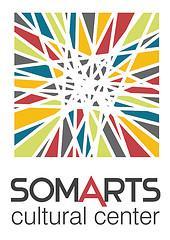
WWW.SOMArts.org

9
From Inception to Erection: The Birth of Man as Object: Reversing the Gaze
Brenda
Oelbaum
Men act and women appear. Men look at women. Women watch themselves being looked at. This determines not only most relations between men and women but also the relation of women to themselves. The surveyor of women in herself is male: the surveyed female…thus she turns herself into an object and most particularly an object of vision: a sight.
John Berger, Ways of Seeing
Since the early years of feminist art, feminist artists have responded to their artistic subjugation by male artists by using their own bodies as subject matter in their art. Danica Phelps credits feminist art of the 1970s with giving her and other artists today the “permission to be personal.”1
To quote Phelps, “Think of how many male painters have done images of women bathing over the years.” And further, “Part of what makes my work feminist is taking authorship of these images.” She describes her shower drawings as a “reversal of the male gaze.”2
There is a difference in these works from those of our male counterparts. We see the nude woman from different angles. The feminist artist chooses a personal vantage point. The viewer of the work becomes part of the body in the picture, making all viewers, be they male or female, feel as if they are
the subject. The contradiction is, however, that the body is still that of a woman. In men’s portrayals of women the figure in the work is seen from outside, not to say that the perspective cannot be skewed, seen from interesting angles, but it is still from the outside looking in, creating an “otherness,” a clear distinction between the observer and the observed.
My goal in this exhibit, Man as Object: Reversing the Gaze, is to turn the tables and to exhibit works that put the male in the position of subject and spectacle. Not only will the male be taking on the traditional female role, but the surveyor is now purely female, no longer a “masculine” part of the female, thus creating a truly feminist stance. The male is the spectacle for a woman’s enjoyment or mere viewing.
This is effective in two ways: as the male viewer encounters the male nude, he, as many women before him, is forced to turn the mirror on himself, and secondly, to feel the powerlessness of being owned or submissive.
By reversing the gaze, the individualism of the artist, the thinker, the patron, the owner, and the woman is transformed. The person who is the object of their activities, the man, is treated as a thing or an
10
abstraction. By reversing the unequal relationship between men and women which is so deeply embedded in our culture (to the degree that it still shapes the consciousness of many women), men will do to themselves what they have done to women for centuries. The men depicted here observe themselves and their own masculinity as women observe their own femininity.
This exhibition marks an important development in feminist art, which has long concentrated on images of women meant to challenge stereotypical notions of womanhood. A gallery filled with works created by women depicting men comments on the prevalence of the male gaze in art and of the continued domination of male artists exhibiting in galleries and museums.
In April of 2005 while attending the 25th Anniversary of ArtTable in New York, I was invited by Ferris Olin to represent The Feminist Art Project for the state of Michigan. The job would entail getting universities, galleries, and museums on board in putting together exhibitions and showing works by women from their permanent collections. It also meant encouraging curators to put together feminist themed exhibitions and writing about the work of women artists. My lack of a direct university affiliation was initially problematic, but institutions such as the Kresge Art Museum in East Lansing, Michigan, jumped on board immediately to relabel Miriam Shapiro’s work, which was already hanging in the museum, thus commemorating The Feminist Art Project and defining Shapiro’s significance in the history of the feminist art movement.
of gaining more information in order to advance my own independent curatorial aspirations, I started to think about what type of show I would like to curate for The Feminist Art Project (TFAP ). Man as Object: Reversing the Gaze came directly from attending the ArtTable events, meeting Ferris Olin at gallerist and collector Fredrieke Taylor’s home, and attending the independent curators’ dinner hosted by Margaret (Peekie) Mathews-Berenson and Donna Harkavy. There I would meet Ruth Weisberg, past president of The Women’s Caucus for Art and recent honoree of a WCA Lifetime Achievement Award. In fact, it was from my association with TFAP that I learned about the WCA, which would not be the natural route, since the later had been around for 30 years while TFAP was in its infancy.
I had long wondered why the response of women artists to being objectified in art was to objectify themselves. To me this did not seem like the ideal response. It didn’t turn the camera back on the viewer or man, so to speak, and I wanted to do exactly that. I researched what similar exhibitions had done in the past and found catalogues from several exhibitions in the UK from the 1980s. Then surprise, surprise! I fell on the review in the New York Times of Ellen Altfest’s Men at the I-20 Gallery in New York City. I immediately contacted her to see if she would be willing to jury a similar Women’s Caucus for Art national exhibition. It was actually from our brief dialogue that the exhibition’s full title came to be Man as Object: Reversing the Gaze. Sadly, as a non-profit, WCA did not have the means to pay for such a high profile juror at the time.
Having attended the ArtTable event with the mission
In the spring of 2006 I had the pleasure of meeting ORLAN while she was a guest speaker at the Michigan Theatre for the University of Michigan’s Penny W.
11
Stamps Distinguished Speaker Series. When I saw her work Origin of War (1989), her response to Gustave Courbet’s infamous painting, Origin of the World (1866), I knew I had the centerpiece of the exhibition. ORLAN’s work was the essence of what I was suggesting for this show. With humor and bravado, ORLAN makes a brilliant riposte to Courbet’s bold commentary.
I envisioned a lenticular3 postcard as the invitation, like the prize in a crackerjack box, where the image would change or move as you handled the card. I saw Courbet’s Origin of the World transforming in a person’s hand from his piece to ORLAN’s Origin of War; female to male in the imagery, male to female


for the artist. It was divine, kitsch, satirical, and ruckus all at the same time, over-the-top and a collector’s item all on its own, a handheld mini-work of art that encapsulated my concept of Man as Object: Reversing the Gaze.
I had heard ORLAN’s discourse about collaborations with computer graphics specialist Pierre Zovilé for her images for The Self-Hybridizations Series: Precolumbian (1998). So with ORLAN's permission we made a contract to print a limited edition of 5,000 lenticular cards.
12
(Left) Gustave Courbet. (1819-1877). The Origin of the World. 1866. Oil on canvas. 18 x 22 inches. 46 x 55 cm. Courtesy of Reunion des Musees Nationaux/Art Resource, NY, Musee d'Orsay, Paris, France
(Right) ORLAN. The Origin of War. 1989. Aluminum-backed Cibachrome. 34 x 40 inches. 102.5 x 87 cm.
When I was approached by Karen Gutfreund in 2010 about a possible follow-up show to California’s highly successful exhibition CONTROL, I told both Karen and Priscilla Otani about my concept for the Man as Object: Reversing the Gaze. I was chock-full of fabulous ideas. I also had great intent and lots of research. I had contacts lined up, including which printers of lenticular art would print what might be deemed pornographic material. I had a list of possible artists to include, the beginnings of essays and prospectus outlines, everything collected over the course of the last six years. It was only with their help and dogged hard work on cleaning things up and making it a cohesive proposal for SOMArts that any of this was possible. Their invitation to
Tanya Augsburg, and their decision to bring her onboard, provided us with an opportunity to include the historic and academic grounding that would give this exhibition its strong foundation and educational relevance.
I am ever so grateful to Tanya Augsburg, ORLAN, the Estates of Sylvia Sleigh and May Wilson, and all the women of the WCA who have banded behind this exhibition, blue chip and/or new chip. It has been so exciting to get an opportunity to work with all of you on such a ground-breaking endeavor.
NOTES
1 Qtd. in Jori Finkel, "Saying the F-Word," ARTnews (Feb. 2007): 118.
2 Ibid.
3 Lenticular printing is a technology in which an array of magnifying lenses is used to produce images with an illusion of depth, or the ability to change or move as the image is viewed from different angles.
13
Introduction: Some Starting Points, Theories, and Themes
Tanya Augsburg
Some Starting Points
Art history and mass media collided in 1972 over controversies concerning the female gaze. The BBC televised Ways of Seeing, a series created by the art critic John Berger, who declared in its companion text: “men act and women appear. Men look at women. Women watch themselves being looked at.”1 That same year during a scholarly panel at the annual conference of the College Art Association art historian Linda Nochlin challenged the masculinist assumptions underlying Berger’s claims. Nochlin compared an erotic photograph from a nineteenth-century French popular magazine of a female nude holding a tray of apples underneath her breasts that was captioned “Achetez des pommes” (which Nochlin translated as Buy My Apples) with her own performative photograph of a male nude model holding a tray of bananas below his exposed penis and scrotum, which she titled, Buy My Bananas. 2 Evidently Nochlin’s photograph was meant to be parodic, not erotic, calling attention to the fact that prevailing cultural norms regarding representations of sexual difference and objectification were not natural. The male nude model with his awkward stance, upturned eyes, and blank facial expression looked clownish, while the visual associations of his penis with bananas seemed way over the top. According to art historian Richard Meyer, Nochlin created a “sensation” with her demonstration of the challenges of objectifying men erotically and aesthetically given existing pictorial conventions.3
Around the same time, Cosmopolitan magazine editor Helen Gurley Brown commissioned the openly gay fashion photographer Francesco Scavullo to photograph film star Burt Reynolds for Cosmopolitan’s first and to this day, most celebrated nude male centerfold. Reynolds directly faces the camera, lying sideways on top of a bear rug with a wry smile and cigarillo dangling almost perpendicularly from his lips. His lean, muscular body and long legs ambiguously convey both the masculine strength of a football player and feminine grace of a ballet dancer, yet his abundant body hair and full moustache leave no doubt that Reynolds is unequivocally male and macho. An arm strategically covers his genitals, but both the cigarillo and his bottom bent knee jutting towards the camera imply that an erect penis is hiding underneath.

14
Figure 1. Burt Reynolds Cosmopolitan Man Pocket Mirror. Circa 1973. (Photo by Tanya Augsburg, 2011. Photo Courtesy of Tanya Augsburg.)
Nevertheless, Reynolds, like Nochlin’s male nude model, averts the viewer’s gaze with his eyes looking away and outside the camera’s field of vision. While Reynolds is both more subtle with his wayward glance and at ease with his body than Nochlin’s staged banana salesman, he too resists being completely objectified.
The April 1972 Cosmopolitan centerfold is widely recognized as the first male nude centerfold within mainstream American popular culture. In retrospect, editor Gurley Brown could be credited for creating a conceptual art piece—a commodifiable one no less— that paved the way for women to look at men as sexual objects. According to writer Jess Cagle, “Cosmo editor Helen Gurley Brown says that the idea of showing male nudity (Playgirl didn't debut until the next year) came to her while `doing the dishes or something,’ she recalls. `I thought, why wouldn't we enjoy looking at a man's body?’''4 American women agreed. The centerfold image was commodified even further. Posters, calendars, pocket mirrors (Fig. 1), key chains and other memorabilia were made and sold. American women appropriated the image of Reynolds for their own pleasures, and in at least one instance replaced Reynold’s face with those of a boyfriend or husband in merriment and in tribute (Fig. 2). As critic Susan Bordo writes in her 1999 study The Male Body, “the Reynolds centerfold, as tame as it now seems, did represent something of a cultural turning point.”5
Berger’s theoretical premises challenged by Nochlin were resoundingly refuted by Gurley Brown. Surely women actively look at men, and not only that—they thoroughly enjoy it. Berger’s assertions about the ways in which women look and see themselves through the eyes of men pointed towards other
pressing issues for women within art history and the art world: those of education, opportunity, agency, and recognition. Think about it: it is not surprising that women had not been recognized or credited as surveyors of men given that women had not been recognized as cultural imagemakers, i.e., artists. As Eleanor Dickinson has pointed out, H. W. Janson’s 1962 authoritative History of Art textbook included “3000 artists from the Old Stone Age to the Present” with no women.6 Responding to the lack of access to representation in 1972, women stormed out of the aforementioned CAA conference and formed The Women’s Caucus for the Art (WCA).
Nochlin had already raised awareness to these issues when she bluntly asked in an article originally published in 1971, “Why Have There Been No Great Women Artists?”7 The question, in Nochlin’s view,

15
Figure 2. Family friends prank Man as Object: Reversing the Gaze curatorial team member and artist Brenda Oelbaum's father on occasion of his 40th birthday, in Toronto, Canada, April 1973. (Photo by Anonymous, 1973. Photo courtesy of the Brenda Oelbaum Collection, Ann Arbor, MI)
was rhetorical; she argues that art history should be asking instead what are the conditions that make great artists possible, pointing out that women were unable to draw male models until the late nineteenth century. How could women artists become great artists if they were not allowed to look at men’s bodies? How could they become recognized as artists if their works were not shown in galleries or museums, let alone were denied opportunities to be able to do their work? Similar problems of lack of education, access, and opportunity existed within other historically male dominated forms of visual culture such as fashion photography and film. To return to our previous example, Gurley Brown had hired a male fashion photographer to photograph Reynolds for women’s visual pleasure, although we can safely assume that she was the one who selected the particular centerfold image out of many others taken.
As the country singer Loretta Lynn sang in a 1978 hit song, we’ve come a long way, baby. 8 The art exhibition Man as Object: Reversing the Gaze recognizes and celebrates women and transgender artists looking at men’s bodies from the origins of the feminist art movement, which is usually traced back to 1970-72, to the present. The exhibition includes several earlier works by Carolee Schneemann, Sylvia Sleigh, May Wilson, and Karen Lance Klaber that illustrate feminist consciousness while establishing some of the major thematic theoretical currents of the exhibition that I have explored as Juror: gazing at men and the erotic male body; discerning the phallus; responding to art history; investigating the performativity of masculinity, and contemplating contemporary eroticism. Overall, the featured and juried works in the exhibition were selected for their engagement in feminist social critique.
Trailblazing Feminist Artists
To a great extent Carolee Schneemann’s pioneering film Fuses (1964-67) paved the way for how women artists and filmmakers to look at men erotically, as Schneemann is the first woman artist and filmmaker to make a sexually explicit and erotic film that does not shy away from including her partner James Tenney’s penis within the camera frame. Schneemann’s keen erotic interest in looking at the male body can be seen with her earliest Cezanne inspired paintings, such as Personae: JT and Three Kitch’s (1957). The vibrant image of Tenney in Personae is a good starting point for an exhibition investigating the myriad of ways women artists look at men. In it Schneemann offers her vision of a muscular, reclining Tenney interconnected with his surrounding environment. The viewer’s eye is both drawn to and away from his erect penis as the painting’s center focal point. Tenney appears vividly alive in a state of sexual anticipation even though Schneemann painted him while he was asleep. The painting illustrates Schneemann’s aesthetic interest in movement, prefiguring her subsequent kinetic assemblages and theater.9 Schneemann’s painterly homage to Cezanne marks yet another major strand of this exhibition, as a considerable number of women artists included in the exhibition respond in unique ways to the male dominated history of art.
Two of May Wilson’s Snowflake collages from 19651972 lent to the exhibition from the Pavel Zoubok Gallery superimpose snowflake images cut out from gay men’s pornography and muscle men booklets over other images of men from the same sources. Wilson’s technique simultaneously made visible and
16
partially obscured men’s bodies. Do the childlike paper snowflake pattern cutouts render the men more childlike, ridiculous, or desirable? Wilson’s Snowflake collages play with these tensions. Writer William S. Wilson has pointed out that Wilson made these Snowflake collages for friends, particularly “young gay men who wanted to be cured of homosexuality,” trying “to show them acceptance by her, which should encourage self-acceptance.”10 May Wilson’s efforts to advance social justice with her choice of subject matter position her as an important trailblazer for Man as Object: Reversing the Gaze. Moreover, Wilson’s Snowflakes can also be regarded as playful reflections on women’s curiosity and erotic desire to see more of men’s bodies than what was shown in mass media at the time. Viewing Wilson’s collages today, we gain more insight into the reasons why the 1972 Cosmopolitan centerfold with Burt Reynolds became so culturally significant.
Another significant work predating the events of 1972 is Sylvia Sleigh’s 1968 oil painting Lawrence and Susana Delgado. Here Sleigh both anticipates and dramatizes the implications of Berger’s claims. Delgado, a well-known Argentinan artist, sits facing the viewer directly with her legs seductively crossed, fully confident and aware that she is being looked at. With her miniskirt and black thigh high boots Delgado is no wallflower. She is the epitome of the phallic woman in psychoanalytic discourse, the Freudian phantasmorphic image of a woman with a penis and/or its associated symbolic representation, the phallus. Sleigh’s husband, Lawrence Alloway, on the other hand, is positioned sideways, avoiding the viewer and looking tense. He sits with his legs spread apart; his folded hands are resting on top of his crotch. Does he have something to hide or is he protecting his manhood from the potentially castrating female artist’s gaze of his wife and/or of
Delgado? If nothing else Lawrence and Susana Delgado depicts male anxiety when placed in a passive, sexually objectified position. That he is positioned in close proximity of a sexually confident woman under his spouse’s surveillance heightens the sense of male internal conflict.
Also included is a print of Karen Lance Klaber’s 1969 charcoal drawing with the ambiguous title, Where’s His Head? Klaber, the publisher of The East Bay Monthly for over four decades, included the following explanation of the origin of the piece with her juried submission: “In 1969, my anthropologist mentor observed that so many men were 'walking around with their heads in their dicks and their dicks in their heads, in a narcissistic trance.' That was the inspiration for this drawing.” Klaber’s satiric drawing calls attention to patriarchal views regarding the phallus. In so doing Klaber renders visible the underlying issue informing a great deal of dominant and domineering masculine attitudes, demeanors, and behaviors: many men’s unfaltering belief in phallic power just because they have penises. Looking at Klaber’s drawing, I can’t help but wonder: What do women artists really think when they look at men nowadays? And what aspects pertaining to men and masculinity are grabbing the attentions of women artists?
Relevant Preceding Art Exhibitions
Man as Object: Reversing the Gaze builds upon the recent explosion of interest in feminist art and feminist art history as evidenced by the successes of recent blockbuster feminist art survey exhibitions
WACK! Art and the Feminist Revolution (2007), Global Feminisms (2007), Elles@CentrePompidou (2009), Modern Women: Women Artists at the Museum of Modern Art (2010) and the critical
17
acclaim for !WAR: Women, Art Revolution (2010), Lynn Hershman Leeson’s extraordinary documentary about the history of the feminist art movement. The brainchild of artist and curatorial team member Brenda Oelbaum, Man as Object: Reversing the Gaze was organized on a shoestring budget with a purely volunteer curatorial team and staff. It was organized in two parts: a representative historical section with works spanning from the late 1950s to the 1990s, and a contemporary juried survey. Almost 300 women and transgender artists submitted nearly 900 works for consideration, which gives some indication of the interest in the exhibition’s themes. Sponsored by the Woman’s Caucus for the Art (WCA), Man As Object was made possible by a curatorial residency at SOMArts in San Francisco awarded to Karen Gutfreund and Priscilla Otani, a successful DIY donor drive, and the generosity of an anonymous donor.
The exhibition’s focus has several significant precedents. In 1975 the Queens Museum in Flushing, New York organized a small exhibition titled Sons & Others: Women Artists See Men, under the direction of Janet Schneider and Kenneth Kahn. Sylvia Sleigh was a participant. The Institute of Contemporary Arts (ICA) in London featured several exhibitions of women’s work in 1980, with Women Looking at Men rousing much controversy for what one critic deemed its “forest of penises” while breaking previous attendance records before touring. 11 As its curators Sarah Kent and Jacqueline Morreau remarked in the Preface of the accompanying exhibition catalogue:
A group of women artists was daring openly to challenge some of the basic assumptions of the culture. Whereas, for instance, a male artist is free to show pictures of the female nude and to share intimacies with
his audience, a reversal of these roles is not welcomed. When a woman picks up the brush, chisel or camera and focuses her attention on the male, she invites an avalanche of patriarchal opprobrium. Men prefer to cling on to their own versions of reality than to accept the unpalatable fact that a woman’s view may undermine carefully protected masculine myths.12
A narrower focus can be gleaned from the 1993 Exhibition What She Wants: Women Artists Look at Men, which was, according to its curator Naomi Salaman, “developed in response to the anti-pornography arguments of the late 1980s, to explore the other side of the debate in terms of visual practice. . . . The exhibition is conceived as an experimental reversal of erotic traditions, consisting of photographic work by over sixty women artists selected from an open submission held over the summer of 1992.”13 In 1994 more that 70 art works were shown as part of The Black Male: Representations of Masculinity in Contemporary Art exhibition that was curated by Thelma Golden at the Whitney Museum of American Art. Serving as a corrective to negative racial stereotypes, this controversial exhibition also included representations of black males in film, television, and rap music. More recently, I-20 Gallery’s 2006 exhibition Men was organized by painter Ellen Altfest and Chicago’s A+D Gallery’s 2007 show Girl on Guy was curated by Marci Rae McDade. Both shows included work by Sylvia Sleigh.14
A Commitment to Diversity
So, given what has already transpired do we really need another exhibition dedicated to women’s images of men? The simple answer is yes, and for
18
the following reason: it has been nearly 40 years since the publication of Berger’s Ways of Seeing, 30 years since Women Looking at Men, and almost 20 years since What She Wants and The Black Male. Much has changed within society, the art world, and theory, and Man as Object: Reversing the Gaze reflects these seismic changes. Man as Object: Reversing the Gaze is a much larger exhibition than its predecessors, with 117 artists participating in the gallery exhibition and an additional 89 artists included in the exhibition catalogue. The artists chosen come from a wide range of diverse backgrounds as do their male subjects, reflecting and representing a society that has become more diverse. Nonetheless, it is important to recognize that achieving diversity within both art institutions and society remains an elusive and incomplete process. As a reflection of contemporary society and culture, this exhibition is no exception despite the curatorial team’s best efforts. Much more work still needs to be done to overcome the very real and harmful effects of continuing negative stereotypes and bigotry. Shizue Seigel’s painting about how Asian men are still stereotyped and labeled, Scrutable (2011), makes this last point patently evident. Seigel juxtaposes a range of descriptive words with her sensitive portrayal of the head and shoulders of an Asian man. In so doing, she challenges the viewer to consider how reading certain words can influence seeing or “reading” Asian men’s bodies.
Included in Seigel’s list of words are both “gay” and “sexless,” signifying how Asian men have been historically viewed in American culture as sexually marginalized and desexualized. Performance artist Chanel Matsunami Govreau as her performance persona Queen Gidrea counters racist sexual stereotypes of Asian men with a blog called
Resexualize. In it Matsunami Govreau documents the research she has conducted in preparation for Hapa Bruthas (2011), her performance as a queer mixed race woman artist exploring representations of Asian American male sexuality in art and popular culture that was specially commissioned for Man as Object: Reversing the Gaze (www.resexualize.tumblr.com).
In contrast, African American, Latino, and working class men continue to be portrayed in mainstream visual culture as hypermasculine and/or oversexualized. A number of artists in the exhibition directly address these stereotypes. At first glance Annie Sprinkle may seem to reify racial stereotypes regarding black men’s penises with both her choice of title and model in Teeny Tiny Big Black Dick (1990). The viewer soon realizes, however, that the title is a provocation. Given the small size of the photograph, the viewer has to really, really want to look at the image to see it well. And to see it well, one has to look real close.
Once the viewer’s eye gets past the towering phallus in the foreground and the blatant symbolism of the erect Freudian cigar behind it, the viewer is confronted with the direct gaze of the male model, who is visibly struggling to raise his head in order to look at the camera. Teeny Tiny Big Black Dick dramatizes the black man’s struggles to make an interactive connection with the viewer by means of sexual display. Moreover, Sprinkle’s photograph makes visible his struggle for his subjectivity to be fully recognized as a unique individual, as well as his struggle to be regarded as more than just a body, symbol, or stereotype. Sal Sidner takes a different approach as she transforms negative stereotypes of African American men by offering an image of a contemplative young African American man with
19
Young Buddha (2009).
The commitment to inclusive diversity is also reflected in the type of artworks selected. Man as Object includes multiple art mediums such as painting, drawing, photography, video, performance, fabric art, sculpture, mixed media, collage, installation, conceptual art, assemblage, print, new media, and digital art. Multiple genres and styles within certain mediums such as painting and drawing are represented, as are remediations that are made in one visual medium to “refashion” works created in another.15 Photographic remediations of paintings include Laura Hartfold’s Graham Reclining (2004) and Eric With Flowers (2004), as well as Xian Mei Qiu’s Ophelia (2011), while Theresa Walloga’s painting Jeans Ad (2010) remediates photo advertising.
The Gaze, the Phallus, and Erotic Male Body Parts
Man as Object: Reversing the Gaze reflects the advancement of theory since the early 1970s— particularly theories regarding the gaze, the phallus, intertextuality, masculinities, and gender performativity. Berger’s assertions regarding the different ways men and women look paved the way for the theorization of the gaze within feminist film theory beginning with Laura Mulvey’s seminal essay “Visual Pleasure and Narrative Cinema” that was published in 1975. Mulvey expanded upon Berger’s ideas, drawing from psychoanalytic theories to assert “an active/passive heterosexual division of labor” controlling the narrative structure of film. For Mulvey, women are depicted as sexual objects intended for the male gaze, as spectacle, and as icons. Men are bearers of the look of the spectator, but “cannot bear the burden of sexual objectification.”16
Mulvey’s essay became canonical in short order. In 1983 E. Ann Kaplan asked the question, “Is the gaze male?”17 and a whole bevy of articles has been written since asserting multiple alternative possibilities for male, female, racial, lesbian, queer, bisexual, and even “gaydar”18 gazes that link the act of looking with visual pleasure, which point to the hazards of attempting to create or maintain essentialist, singular, or even definitive categories regarding gender, racial, or sexual identities. Nevertheless, several artists in the exhibition depict the female heterosexual gaze in action: Clara Saprasa with her 2011 painting Object; Madelyn Smoak with her cat glasses-shaped jewelry pendant and chain, David and His Junk (2011); and Lynn Elliott Letterman’s lusty photograph Construction Guy (2010). Unlike film, which establishes the gaze through narrative, in these static images the active female gaze is made visible through the depiction of reflective lenses. We see the psychological impact of being looked at and exposed on three cowering men in Hazel Bartram-Birchenough’s painting Anatomic Series 1 (2010), while Karen Zack with Mankind 2 (2010) depicts three men whose exaggerated poses communicate their collective wish to be objectified.
Looking at some of the art in this exhibition, I detect additional types of gazes. In Discipline and Punish the late philosopher Michel Foucault described the origins of technologies designed for the mechanisms of modern surveillance.19 We see how male surveillance of women can be surveilled from a distance with Lynn Hershman’s Robert Meets Mr. America Irwin-2 (1975) from her Meet Mr. America photographic series. As her fictional persona Roberta Breitmore Hershman met men who had answered Roberta’s personal ads with letters. The meetings were secretly documented, exposing the behavior of
20
men during such awkward first face-to-face encounters. Hershman demonstrates various techniques by which women can reverse the male gaze and dismantle its more pernicious effects: by transferring its usual setting from the private sphere into the public realm, by exposing and documenting it with surveillance technologies, and perhaps most empowering for women, by taking complete control of the conditions in which it takes place. Such methodologies have served Hershman well as a feminist filmmaker and director, which she points out in the text she wrote specifically for this catalogue; “Complicit Object—Reversing the Gaze.”
Foucault also wrote on medical, clinical, and scientific gazes while also tracing the rise of both the medical clinic and the scientific study of sex, which he called scientia sexualis. 21 Carolee Schneemann takes on the scientific gaze with her own sexological survey based on 40 actual sexual encounters and charts her “findings” in Sexual Parameters (1971). Schneemann asserts the importance of learning from one’s own experiences even appropriating scientific methods. Thus she records more than frequency, duration, and penis size; she documents subjective qualities such as emotions, impressions and memories to give a more holistic profile of each lover. J. Toffic alludes to a scientific gaze that predates modern science the tradition within natural history of collecting and classifying artifacts. With The Collector (2010) Toffic spoofs traditional cabinets of curiosities with a tongue-in-cheek collection of penis specimens.
Given that cabinets of curiosities were also found in ethnographic and anthropological museums, the feminist interrogation of additional “objective” gazes can be observed with Toffic’s The Collector, particularly the ethnographic gaze, the colonial gaze,
and the imperialist gaze. Tamarra Kaida overtly satirizes “studies” of two different male occupational “types:” Dan Noel (Scholar/Writer) (1999) and Russian Photographer with Contact Sheet (1999). In contrast, Alexandra Walker’s photographic studies Driver (2011), Resting (2011), and Jacob (2011) seem to blur ethnographic study of working class white men with the tradition of social documentary photography. What are we to make of Jacob’s creepy stare, let alone his gun?
Other works such as Amelia Lewis’s 2010 painting Tribesman (Native), Heather Pilapil’s painting Errol (2004), and Juana Alicia’s painting Citizen (1998) defy ethnographic gaze’s tendency to degrade its subjects into exotic “others” in attempt to document or “study” them. Indeed, some works in the exhibition endeavor to dismantle the ethnographic gaze altogether. For example, Allison Leach’s photographs Sexy Beast (2008), Jacques Cluelez (2008), and Shy Savage (2008) are scathing in their mockery of white man’s sense of entitlement, which in the artist’s own words, “examines the hubris of Western exploration.” Pallavi Govindnathan questions gender presumptions of the colonial/imperial gaze with her photograph, Historical Inequality (2011) as does Juana Alicia with her striking painting, The War Voyeurs (1991). Juana Alicia’s painting records a specific historical moment: the First Gulf War in 1990. Her depiction of an Iraqi woman returning the gaze of American soldiers captures what has usually been found missing in history: women’s perspectives. Juana Alicia deconstructs male imperialist and militaristic gazes by reflecting them back through the eyes of the Iraqi woman. Julie Sutherland addresses another tendency of history’s purview: the minimalization of women’s contributions. Sutherland makes visible the old adage “Behind every great man
21
is a woman” with her historical/herstorical paintings, Marthageorge Washington (2010) and Dollyjames Madison (2010).
The results of what I would call “familial gazes” and domestic gazes can also be seen throughout the exhibition. We see the daughter’s loving filial gaze at work with Bonnie J. Smith’s DAD (2008) and Reena Burton’s Papa (2007). Christina Renfer Vogel scrutinizes family resemblances between her male siblings in Portrait of Two Brothers (2008). Lynda A. N. Reyes highlights the close ties between Albert and Allen, presumably from the mother/wife’s conflated perspective in Father and Son (1997). Juana Alicia’s Corazón de Melon (2009) asserts an erotic, loving and deeply appreciative “marital” gaze, as does Jasmine Begeski’s photograph of her reclining husband, Lay (2009), which along with Window (2009) and In Hand (2009) documents the couple’s struggle with infertility. Amy-Elyse Neer’s The Affair (2009) and Mette Tommerup’s Newspaper (2010) illustrate that the marital gaze can be imbued with ambivalence,
critique, and even contempt.
As already indicated, gazes can be multiple, hybrid, overlapping, ambiguous, ambivalent, and even paradoxical as they reflect the viewer’s positioning(s) at any given point of time. Female gazes as erotic gazes remains paramount in Man as Object: Reversing the Gaze. Men are depicted as objects of desire, fantasy figures, lovers, partners, and husbands, which can help explain why the female heterosexual erotic gaze at times coincides with, and differs from, gay male gazes. The erotic gaze irrespective of sexual preference with its scopophilliac pleasures often leads to voyeurism. In her painting Victorian Keyhole (2011) Sharon Leong’s painting both aestheticizes and thematizes voyeurism of men with ornamental flourish.
The erotic gaze also leads to fetishism. I leave aside feminist debates over the utility of classic psychoanalytic theories of the fetish for women due to the fact that many of the artists of Man as Object: Reversing the Gaze zero in on the erotic qualities of particular male body parts. Sheila Winner with Unbuttoned (2011), Sita Mae with The Triumph (2008), and Mel Ahlborn with Cathouse-Appetizer (2011) accentuate alluring qualities of the male torso and chest. As part of a series, Cathouse-Appetizer needs to be considered with another view of the male torso, Cathouse-Entrée (2011), and Cathouse-Dessert (2011), which provides a frontal view of a semi-reclining male nude’s body.
Moreover, Man as Object: Reversing the Gaze features a panoply of sensuous rear views of men and alluring images of male backsides. These include Janice Nesser’s climbling out of the white (2008), Marlene Hawthorne Thomas’s Untitled (From the Study of Man Series) (2009), Nicole Craine’s Untitled Nude (2010), Lorena Sanguiliano’s Body Builder I (2010), Trix Rosen’s Beyond XY: Inside the Abandoned Falstaff Brewery, No. 2 (2010), Sara Hopkins’s Turn Over (2010), and Annelise Jarvis-Hansen, The Beautiful Hu-Man (2010). The male butt in Della Calfee’s Ass Like That (1992) affirms traditional Kantian aesthetics’ emphasis on symmetry for beauty more specifically, its symmetry between between convex and concave forms as well as between light and dark shadows. Yet traditional Kantian aesthetics alone doesn’t seem to explain completely why it strikes the viewer to use the vernacular as one hot piece of ass. Could it be that those pinchable butt cheeks have something to do with it?
As mentioned previously, a considerable amount of erotic and critical attention in the exhibition focuses
22
on the penis and the phallus. The visual display of actual penises particularly non-erect penises is rare, given that no real penis can ever live up to what Richard Dyer has called “the mystique implied by the phallus.20 We are left with a lingering question: is a visual representation of a penis ever just a representation of a penis? Carla Sanders’s array of drawn penises in 9 Cocks (2010) seems innocent enough—until the viewer starts making comparisons. Michelle Lopez offers close up views of penises and scrotums with her black and white photographs without much commentary. With Lopez’s Male Nude #1 (2010) the viewer sees a flaccid penis from an unusual side angle that makes it appear almost flat. The singularity of such an image, I think, speaks volumes. Both Judy Johnson-William’s With Hoodie (2011) and Nanette Wylde’s Pinkie (1992) provide examinations of penis tips. Such close observations allude to, as well as counter, the prevalence of “pink and open” shots of female genitalia in mainstream pornography beginning with Larry Flynt’s Hustler magazine, while their use of diminutive names for their titles calls attention to the wide-spread use of slang terms for female anatomy.
A few artists utilize humor to create dissembling odes to the phallus. Aisjah Hopkins’s penises in Contentment (1987) and Agreement (1987) appear as luscious rosy fruit sprouting in thickets. The penis is gift wrapped in Nicole Craine’s Bow (2010) and bejeweled in Arabella Decker’s playfully ironic Family Jewels (2005). Corinne Whitaker transforms it into a shiny metallic ornament in Ornamental Man (2010), and Trudi Charnoff Hauptman puts it away in a special storage box for safekeeping in Open Only on Special Occasions (2010).
Other artists deploy approaches that range from
subtle critique to biting satire. The legacy of the white penis as phallus is noted without any obvious fanfare with Ruth Water’s alabaster marble sculpture Penis (1995). But perhaps Water’s understatement is precisely the point. Judith Segall tells it like she sees it with You’ve Seen One, You’ve Seen ‘Em All (1994). Segall goes one step further in Penises and Tallises (Thou Shalt Put No Gods Before Me) 1996, juxtaposing the penis-as-phallus with the symbolic law of the Father (Jewish law). In so doing she locates the source of male phallic power and superiority within the sanctions of religion. As phallus, a handsaw becomes a menacing tool for domination in Jacki Orr’s Veni Vidi Vici (2009).
Alternatively, Elizabeth Stephens addresses penis size mythologies from a lesbian-turned-ecosexual perspective with her bronze sculpture, Ron Jeremy’s BVDs (2008). Porn star Ron Jeremy is legendary for the size of his cock; however, Stephens regards the penis as just “one erotic object in a field of visual objects.” In an email Stephens writes: “I find more erotic, for instance female genitalia, trees, dirt, water, mountains and in terms of this competition it doesn't really stand up as the most powerful object of desire.”22 Stephens gazes beyond Jeremy’s famous anatomy to focus on the abject qualities of his dirty underwear. Unimpressed by either the length or girth of a penis, Stephens provides a humorous reality check to those willing to ignore a man’s unsightly appearance and lack of personal hygiene just because he has a big you-know-what.
Juana Alicia provides intriguing counterpoints with her intimate painting, Corazón de Melon.
Juana Alicia focuses the viewer’s attention on male body parts that can provide much female sensation and pleasure: the mouth, the lips, and the tongue. In so doing, Juana Alicia reminds heterosexual women
23
to look beyond the penis as a source for female sexual pleasure.
Intertextualities and Appropriations
In the 1960s Julie Kristeva invented the term “intertexuality,” which refers to the relationalities between texts.23 Given the premises of Man as Object: Reversing the Gaze it is not surprising to note the prevalence of women artists recalling, referencing, and commenting upon previous art works, literary texts, and even critical theories that have shaped masculinist art visual culture and the ways we think about visual culture and art. The most prominent example of intertextuality in the exhibition was also its source of inspiration: ORLAN’s Origin of War (1989) (Fig. 4), which is a flagrantly feminist response to Courbet’s notorious Origin of
the World (1866) (Fig. 3).
ORLAN replaces the woman’s vulva in Courbet’s painting with an erect penis in her photograph. ORLAN not only diminishes the power of the phallus by ascribing to it only a mediocre size;24 she boldly asserts that it is responsible for society’s ultimate act of violence with her choice of title, and she commemorates that viewpoint by including the gilded frame as part of her piece.


Photographer Della Calfee repurposes men’s bodies while recalling ancient Greek Erechtheum temples with stone pillars carved in the shape of Caryaid maidens in her photograph, Men as Table (1991).
Xian Mei Qiu gives art history a queer twist with In the Manner of Gabrielle d’Estrees (2011). The
24
(left, figure 3) Gustave Courbet. (1819-1877). The Origin of the World. 1866. Oil on canvas. 18 x 22 inches. 46 x 55 cm. Courtesy of Reunion des Musees Nationaux/Art Resource, NY, Musee d'Orsay, Paris, France.
(right, figure 4) ORLAN. The Origin of War. 1989. Aluminum-backed Cibachrome. 34 x 40 inches. 102.5 x 87 cm.
viewer is left to wonder what are the resonances between the original painting of King Henry IV of France’s mistress and her sister and the two male soldiers of color in Qiu’s photograph. Olga Alexander cleverly turns the table on de Kooning’s Woman paintings with her own painting, Man (2011). The tradition of Venus at the bath is given a contemporary role reversal with Lynn Friedman’s photograph Bedtime (2010); Nancy Netherland’s Bath (2011); Karen Henninger’s Man in Tub (1999); Nora Raggio’s Andres Vulnerable to the Camera (2011), and Andres Before His PHD Dissertation Soaking in the Bathtub (2011). Raphael’s The Three Graces (1504-1505) is the source of inspiration for the male figures of Yuriko Takata’s The Three Graces Paperboy Dolls (2011).
Michal Gavish’s watercolor, Life Drawing on a Couch: Homage to Zigmund and Lucian (2011) takes on the dual legacies of Sigmund Freud: his theories and his grandson, the late painter Lucian Freud. Gavish replaces “Big Sue,” the model of Lucian Freud’s famous painting Benefits Supervisor Sleeping (1995), with an equally rotund older man. Given that Freud’s painting broke the world record in 2008 for the highest price for a painting by a living artist ($33.6 million), Gavish’s choice of tribute also speaks to women artists’ ongoing struggle for equal compensation. On a more positive note, Tracy Brown illustrates how earlier feminist art history can inspire younger feminist artists with her witty remediation of Nochlin’s aforementioned notorious photograph, B-A-N-A-N-A-S (2011).
The intertextual references extend to other types of texts as well. Kelsi Mannhalter parodies Playboy magazine with Pleazboy (2011) and advertisement for women with Smooth (2011). Jenny Wrenn references gay male porn imagery with her painting
The Traffic Stop (2007). Cat Lynch revamps pulp detective novels with gender performativity in The Perfect Gentleman, from the Pulp Series (2010) and The Lone Wolf (2010), while Jeanette May incorporates quotations from female writers within the frames of her performative photographs Easy on the Eyes: Lelia (2010) and Easy on the Eyes: Dorothy (2010). We see a contemporary retelling of an ancient myth of role reversal without any sugarcoating in Erika Meriaux’s painting Heracles and Omphale (2010). Sheila Finnigan appropriates both Gertrude Stein’s highbrow modernist poetry and Walt Disney’s pop culture Pinochio in her postmodernist satire, A nose is a nose is a nose (2011).
Jill O’Bryan responds to all the feminist theory written in response to the theories of psychoanalyst Jacque Lacan, particularly his ideas on the phallus as the signifier of the law of the father. More specifically, O’Bryan addresses the fetishization of Lacianian theory by creating headfuck/bodystamp (2011), a mock page of U.S. postal stamps. Lacan is shown to have been quite the male pin-up while holding a Freudian cigar. By objectifying Lacan, O’Bryan directly challenges feminist investments in his theories.
MasculinitiesandGenderPerformativity
So much was written (mostly by heterosexual men) on the analysis of men and masculinity when the interdisciplinary field of masculinity studies emerged during the 1990s that at least one scholar deemed it by 2000 as “academic Viagra.”25 Among the more influential studies written during this period was Masculinities (1995) by Australian sociologist R. W. Connell, who posits that masculinity is a relational term, one that only has meaning in relation to the concept of femininity.26 We see
25
Connell’s view affirmed in the depiction of men as lovers, husbands, friends, fathers, brothers, and even prospective suitors. Does Diana Krevsky’s satiric caricature, Beware of the Troll Man (1993), for instance, reflect more men on a date or heterosexual women’s oft-quixotic struggles to meet Mr. Right? Connell furthermore examines the social construction of what he calls “hegemonic masculinity”:
Hegemonic masculinity can be defined as the configuration of gender practice which embodies the currently accepted answer to the problem of the legitimacy of patriarchy, which guarantees (or is taken to guarantee) the dominant position of men and the subordination of women. 27
What constitutes hegemonic masculinity is neither static nor fixed. Connell suggests that it is much more precarious and transitory than what is commonly believed. With her conceptual painting Power Authority Masculine (2011), Karen Gutfreund reviews some of the ways hegemonic masculinity is currently articulated through social roles, clothing, and language in American society.
Since hegemonic masculinity is exalted above the rest, Connell makes the case that there is not one masculinity, but multiple masculinities existing simultaneously in any culture. In effect, Connell argues that to understand multiple masculinities, we have to examine how they are socially organized, produced, practiced, and reproduced, which is why this exhibition is not just about looking at men and masculinity, but about examining society. What are women artists’ views about the links between men and sports, for example? Jan Wurm seems to affirm
sociological views regarding male socialization and competitiveness with Golfers (2009). Adoration in the Steroid Era (2010), Priscilla Otani’s playful conceptual work comprised of a baseball bat and two balls, raises questions about American culture’s worship of players such as Jose Canseco whose physical prowess has recently been revealed to be attributed to steroid usage. Another humorous conceptual work, Brenda Oelbaum’s Does This Make My Dick Look Big?
Carpe Carp II (2011), links amateur fishermen’s perchant to display proudly their catches to the male obsession with penis size.
A number of works in Man as Object: Reversing the Gaze seem to have been inspired by Judith Butler’s evolving theories of gender performativity, which since the publication of her seminal Gender Trouble in 1990 have greatly contributed to new understandings of gender. Gender for Butler is a repetitive act, a performance, a “kind of persistent improvisation that passes for the real.”28 As perhaps the most visible type of gender performance due to its either parodic or hyperbolic repetitions, gestures, and corporal stylings, drag points to “a certain ambivalence”29 about having one’s masculinity being viewed by hegemonic heterosexuality—to use Butler’s term—as subordinate or marginalized. The drag queens in Linda Friedman Schmidt’s When Everyday Is Halloween (2008), Karen Mathew’s Lips (2008), and Emily Yost’s Untitled (‘Faux Queen’) (2011) are shown to convey that ambivalence with intention and dignity.
Drawing from Butler cultural theorist Judith Halberstam claims in her monumental 1998 study, Female Masculinity, “it is crucial to recognize that masculinity does not belong solely to men, has not been produced only by men, and does not properly express male heterosexuality.”30 Artist Nancy
26
Grossman anticipated Halberstam’s ideas with her art, particularly, her carved life-sized head sculptures wrapped in black leather dating back from the 1960s to 1980s (See Fig. 5). By referring to these iconic heads as self-portraits, Grossman suggests that masculine qualities conventionally attributed to men—such as aggression, strength, cruelty, and sadism—can be expressed by everyone.

Halberstam devotes a chapter on lesbian drag king performance to make her case. Man as Object: Reversing the Gaze includes performative photographs and video performances of female
masculinity and drag kings because women artists’ embodied knowledge of masculinities can be rendered visible through performance, gesture, and corporal styling. Such knowledge is often the result of looking closely at men and their behaviors, which is why performance, perhaps more than any other art medium, can be used as a feminist strategy to expose men’s rituals of domination, whether it be through imitation, parody, or stylized hyperbole. For example, queer performance artist Tania Hammidi celebrates her self-fashioned female masculinity in her glamorous photographic self-portrait, Look (2011).
27
Figure 5. Nancy Grossman (b.1940).
Haifisch. 1970. Leather, wood, porcelain and hardware. 16 x 8 x 10 inches, signed and dated. Courtesy of Michael Rosenfeld Gallery LLC, New York, NY.
Annie Sprinkle’s performative photographs that make up The Seven Men Inside Katherine Gates (1990), which she did in collaboration with artist Katherine Gates, are early yet sophisticated examples of drag king performances—particularly the photographic performance of Gates as a drag king performing as the male drag queen “Bubbles” Galore parodying a heterosexual woman. Does it matter much that Sprinkle’s collaborator is a heterosexual woman? It shouldn’t, because according to Halberstam, neither female masculinity nor drag king performance is exclusively lesbian.31 A more recent example of drag king photographic performance is Hammidi’s reflective self-portrait Mirrors of He (2008), which suggests that there is no original nor prototypical image of masculinity. During her remarkable video Playing Peter (2007), Erika Swinson documents the process of how quickly and easily the female body can be modified to appear masculine. All a girl needs is some duct tape eye pencil, socks, boxers, and a good suit. Swinson then performs male rituals such as shaving, reading a newspaper, and smoking a cigar.
Along with Butler and Halberstam’s respective groundbreaking scholarship, these works by Sprinkle, Hammidi, and Swinson raise some important questions for the exhibition: Who gets to be recognized and acknowledged as a man? Or a woman artist? What about those who are queer and transgender, as in the case of Molly Marie Nuzzo’s Noah (2011), or those who confound gender categories and sexual identities, as in the case of Tristan Crane’s “genderfucking”32 photographic subjects, the underground porn stars James Darling, Quinn Valentine, and Dex Hardlove? By destabilizing gender and sexual identities Nuzzo’s and Crane’s subjects envision new possibilities.
Eroticism, Pornography, and the Impact of New Media Technologies
And what do the works in Man as Object: Reversing the Gaze reveal about contemporary sexuality and eroticism? Already in 1993 Linda Williams observed that “distinctions between the erotic and the pornographic are often elusive, sometimes irrelevant and always political.”33 Yet Williams was able to assert a basic distinction:
Pornography aims frankly at arousal; it addresses the bodies to its observers in their sexual desires and pleasures. It boldly sells this sexual address to viewers as a commodity and it does not let aesthetic concerns or cultural prohibitions limit what it shows. Erotic art, on the other hand, is traditionally much less bold and (somewhat) less commercial. Because it is committed to the ideals of an art which is supposed to beyond commodification and to reside within the rational limits of good taste, it does not directly (although it may indirectly) `sell’ its sexual address.34
Since then, the distinctions have become arguably even murkier as the impact of digital and new media technologies on contemporary sexuality, eroticism, and pornography is undeniable. For example, we see no shortage of male exhibitionism within the exhibition, as there are multiple images of men’s crotches with legs spread apart: Ellen Kieffer’s Subjective Perspective (2010), Zina Al-Shukri’s Look Into My Eyes (2010), Sara Hopkin’s Spread Your Legs (2011), and Elizabeth Sowell-Zak’s Personality: Angel Seated (2010). Somewhat related to exhibitionism are S&M role playing and displays of bondage, and we see several bounded submissive men with
28
Merrilyn Duzy’s Bound (2009), Carolyn Weltman’s Gods and Men (2008), and Nancy Peach’s Male Bondage (2011).
Images of male autoeroticism abound in the exhibition, perhaps as the ultimate form of contemporary American individualism what Robert Putnam categorized as “Bowling Alone.”35 These masters of their own domain (to borrow a euphemism from a famous Seinfeld episode, “The Contest”) appear completely self-involved in their pleasure, unaware of their surroundings or of others. They appear in Merrilyn Duzy’s painting Repose (2009); Sharon Leong’s paintings Handgela (2002); Jan Wurm’s painting Reverie (2008/9); Tristan Crane’s photograph Cassidy (2011), Shilo McCabe’s photographs Jim (2011), Ned (2011), and Damani (2011); and Amy-Eyse Neer’s The Affair (2009). In all of these works, the viewers are positioned as voyeurs, not invited participants.
I expected to see many images of penises and phalluses, aware of the tradition of “prick artists.”36 I must admit I did not anticipate the number of images of onanism submitted. What threw me entirely for a loop was to see how within these images men seem blissfully unaware of the viewer or their surroundings. I wondered: must images of men masturbating position the viewer as an intruding voyeur? Do these images reflect a society that is increasingly isolated and alienated from others, including one’s sexual partners? Or are they suggesting that one doesn’t need a sexual partner to reach fulfillment, validating masturbation as an important part of sexuality?
In contrast to Annie Sprinkle’s Teeny Tiny Big Black Dick, these more recent works for the most part do not suggest sexual connection. M. Ode to Fritz Lang
Redux (2011), Melissa P. Wolf’s digital sequential still photographs of a flat screen monitor playing The Chelsea Tapes (1983-1995), the video she made with her then partner (now husband and art collaborator) Paul Lamarre, documents male masturbation as part of an artistic collaboration as well as sexual connection. During The Chelsea Tapes, Lamarre performs for the viewer and Wolf, who is behind the video camera, as he jerks off and eventually ejaculates. With her still photographs of “the money shot,” Wolf both challenges her audience and makes several critical points. The first main point calls attention to cultural prohibitions regarding the visual representation of the money shot. As Linda Williams has pointed out, the money shot is part of what women frequently see when viewing the male body in pornographic video and film even though it functions in pornography primarily as a fetish for men. 37 Its representation does not seem to exist outside of the pornographic realm even though women can (but not always) view men ejaculating during heterosexual sex. Wolf’s photographic triptych is an exploration of how men’s ejaculating bodies may be artistically represented. Second, M. Ode to Fritz Lang Redux is a testament of how mediated eroticism and sexuality have become—a point that Shilo McCabe also makes vividly with her photograph Damani. Finally, third, Wolf’s images are a reflection of the extent to which the distinctions between erotic and the pornographic have become blurred.
The Weiner Effect
By happenstance this exhibition can be considered extremely timely. During the period I was jurying this exhibition in May-June 2011, Arnold Schwarzenegger was exposed for having had an extramarital affair
29
with his housekeeper, fathering a child with her. Congressman Anthony Weiner of New York tweeted a crotch shot, apparently by mistake, which ultimately resulted in even more intimate and explicit photos being released that led to his reluctant and teary-eyed resignation. These examples and others (think John Edwards and New York State politician John Lee) beg the question: why can’t these guys in power keep their pants zipped? In the case of Arnold Schwarzenegger, perhaps the biggest shocker was that this news did not become public earlier. The Guerilla Girls on Tour’s poster My Fellow Californians (2007) did attempt to warn the electorate about the former California governor’s past record as a groper and sexual harasser to no avail. With the case of Anthony Weiner, the American public witnessed a white male politician’s desperate call for attention, to be looked at and admired (in the case of his tweeted bulging underpants shot, for example, the photo was sent “as a joke,” unsolicited).
Perhaps men like these can learn from our exhibition, to see how women view them. . . or choose not to. Is it at all astonishing that no image of an actual white male politician in a suit was submitted to the exhibition? Such omissions seem to confirm Halberstam’s claim that “masculinity. . . becomes legible as masculinity where and when it leaves the white male middle class body.”38 Nevertheless, I can’t help but think that the lack of such images also suggests that women artists may share Halberstam’s “degree of indifference to the whiteness of the male and the masculinity of the white male and the project of naming his power.”39 Are women artists deliberately ignoring socially, politically, and financially powerful men with their displays of dominant and hegemonic masculinity?
Are women artists intentionally choosing not to represent them as artistic expressions of feminist resistance, critique and empowerment? Could it be that women artists simply do not find the actual bodies of white men who wear suits all that compelling aesthetically, let alone erotically appealing? The exhibition Man as Object: Reversing the Gaze leaves it up to its viewers to draw their own conclusions.
30
NOTES
1 John Berger, Ways of Seeing (London: British Broadcasting Corporation and Penguin, 1972), 47.
2 Linda Nochlin, “Starting from Scratch: The Beginning of Feminist Art History,” in The Power of Feminist Art: The American Movement of the 1970s, History and Impact, eds. Norma Broude and Mary D. Garrard (New York: Harry N. Abrams, 1994), 135-136. Buy My Apples and Nochlin’s photograph Buy My Bananas (1972) are reproduced on page 136.
3 For a full account and analysis along with reproductions of the nineteenth-century photograph and Nochlin’s Buy My Bananas (1972) see Richard Meyer, “Hard Targets: Male Bodies, Feminist Art, and the Force of Censorship in the 1970s” in WACK!: Art and the Feminist Revolution, ed. Lisa Gabrielle Mark (Los Angeles: Museum of Contemporary Art, Los Angeles, 2007), 364-371.
4 Cagle, Jess. “Reynolds Unwrapped.” EW.Com 27, March 1992 http://www.ew.com/ew/article/0,,309960,00.html
5 Susan Bordo, The Male Body: A New Look at Men in Public and Private (New York: Farrah, Straus and Giroux, 1999), 18.
6 Eleanor Dickinson, “Interview with H. W. Janson, February 1, 1979,” College Art Association , Women Artist News, September/October 1979, 12. Qtd. in Eleanor Dickinson, “Report on the History of the Women’s Caucus for Art” in Blaze: Discourse on Art, Women and Feminism, eds. Karen Frostig and Kathy A. Halamka (Newcatstle upon Tyne: Cambridge Scholars Publishing, 2007), 38.
7 Linda Nochlin, “Why Have There Been No Great Women Artists?” Women, Art, Power (Harper & Row, 1988), 145-178.
8 Loretta Lynn’s song “We’ve Come a Long Way, Baby” was one of the top country songs of 1978. See the website Playlist Research: A Resource for Music Researchers. http://www.playlistresearch.com/1970s/1978countryhits.htm. The lyrics are easily accessible online, and one can view several versions of Loretta Lynn singing the song on YouTube.
9 For more detailed discussion of the “abstract figurative” style of Schneeman’s early paintings, see Kristine Stiles, “The Painter as an Instrument of Real Time,” in Carolee Schneeman, Imaging Her Erotics: Essays, Interviews, Projects. Cambridge, MA and London: MIT Press, 2002, 3-16.
10 William S. Wilson, email correspondence to the author, August 13, 2011.
11 Sarah Kent and Jacqueline Morreau, “Lighting a Candle,” in Women’s Images of Men, eds. Sarah Kent and Jacqueline Morreau (London: Pandora, 1990), 20.
12 Sarah Kent and Jacqueline Morreau, “Preface” in Women’s Images of Men, eds. Sarah Kent and Jacqueline Morreau (London: Writers & Readers Publishing, 1985), 1.
13 Naomi Salaman, “Introduction,” in What She Wants: Women Artists Look at Men, ed. Naomi Salaman, Intro. by Linda Williams (London and New York, Verso: 1994), 65.
14 For more information on the 2007 Girl on Guy exhibition see http://cms.colum.edu/girlonguy/.
15 See Jay Bolter and Richard Grusin, Remediations (Cambridge, MA: MIT Press, 2004) for more about remediations.
16 Laura Mulvey, “Visual Pleasure and Narrative Cinema,” in Patricia Erens (ed), Issues in Feminist Film Criticism (Bloomington and Indianapolis: Indiana University Press, 1990), 34. Originally published in Screen 16, no. 3 (Autumn 1975), 6-18.
17
E. Ann Kaplan, Women and Film: Both Sides of the Camera (New York and London: Routledge, 1983), 23-35.
18 Cheryl L. Nicholas, “Gaydar: Eye-Gaze as Identity Recognition Among Gay Men and Lesbians,” Sexuality & Culture 8, no. 1 (2004): 60-86.
19 Michel Foucault, Discipline and Punish: The Birth of the Prison, trans. Alan Sheridan (New York: Vintage Books, 1977).
20 Michel Foucault, The History of Sexuality, Volume 1: An Introduction, trans. Robert Hurley (New York: Pantheon Books, 1978). See also Michel Foucault, The Birth of the Clinic: An Archeology of Medical Perception, trans. A. M. Sheridan Smith (New York: Pantheon Books, 1973).
31
21 Richard Dyer, “Don’t Look Now,” Screen, 23, nos. 3-4 (1982), 72. See also Lola Young, “Mapping Male Bodies: Thoughts on Gendered and Racialized Looking,” in What She Wants: Women Artists Look at Men, ed. Naomi Salaman, Intro. by Linda Williams (London: Verso, 1994), 41-42.
22 Elizabeth Stephens, email correspondence with the author, August 14, 2011.
23 See Julia Kristeva, Desire in Language: A Semiotic Approach to Literature and Art (New York: Columbia University Press, 1980).
24 Simon Donger, “Hybridity and Alterity in ORLAN’s Seductive Acts of Dis/Connection,” in ORLAN: A Hybrid Body of Art-Works, ed. Simon Donger with Simon Shepard and ORLAN (London and New York: Routledge, 2010), 162.
25 Bryce Traister, “Academic Viagra: The Rise of American Masculinity Studies,” American Quarterly, Vol. 52, no. 2 (June 2000): 274-304.
26 R. W. Connell, Masculinities, 2nd ed. (Berkeley and Los Angeles: University of California Press, 2005), 43. Originally published in 1995.
27 Ibid., 77.
28 Judith Butler, Gender Trouble: Feminism and the Subversion of Identity (New York and London: Routledge, 1990), x.
29 Judith Butler, “Gender is Burning,” Bodies that Matter (New York & London: Routledge, 1993), 125.
20 Judith Halberstam, Female Masculinity (Durham and London: 1998), 241.
31 Ibid., 240.
32 For more on the origins of the term “genderfuck,” see Elisa Glick, “Sex Positive: Feminism, Queer Theory, and the Politics of Transgression,” Feminist Review 64, (2000): 19-45.
33 Linda Williams, “Introduction: What Do I See? What Do I Want?” in What She Wants: Women Artists Look at Men, ed. Naomi Salaman, Intro. by Linda Williams (London and New York, 1994), 3.
34 Ibid., 5.
35 Robert Putnam, “Bowling Alone: America’s Declining Social Capital,” Journal of Democracy 6, no. 1 (1995): 65-78. See also Bowling Alone: The Collapse and Revival of American Community (New York: Simon & Schuster, 2000).
36 Meyer, “Hard Targets,” 363, n. 2.
37 Linda Williams, Hard Core: Power, Pleasure, and the “Frenzy of the Visible” (Berkeley and Los Angeles: University of California Press, 1989).
38 Halberstam, Female Masculinity, 2.
39 Ibid., 3.
32
FEATURED ARTISTS
Juana Alicia
Nancy Buchanan
Guerrilla Girls On Tour!
Lynn Hershman
Jill O'Bryan
ORLAN
Carolee Schneemann
Sylvia Sleigh
Annie Sprinkle
Elizabeth Stephens
May Wilson
Melissa Wolf
33

34
Juana Alicia. Corazón de Melon. 2009. Acrylic on canvas. 24 x 36 inches.
I believe that it is my responsibility as an artist to be an activist for social justice, human rights and environmental health, and I see the work of parenting and teaching akin to being an artist. I began working as an artist in my teens, coming of age in the human rights movements that included the United Farm Workers and that protested the war in Vietnam. My work has always be concerned with the conditions we face as women in dealing with how an unequal and often violent world treats us on the basis of our gender. From issues of war, rape, incest, urban violence, unnecessary medical interventions to workplace discrimination, my work has critiqued discrimination, as well it has celebrated our valor and creativity. In considering the themes of Man as Object: Reversing the Gaze, I had multiple responses: should we simply turn the tables of repression and violence in a “see how it feels” response to our subjugation? Or should we instead seek a more evolved response to the depiction of men, seeking some kind of understanding and compassion?


35
(left) Juana Alicia. Citizen. 1998. Fresco on wood panel. 6 x 48 inches.
(right) Juana Alicia. The War Voyeurs. 1991. Acrylic on canvas. 3 x 5 feet.
Please Sing Along positions beautiful men as objects to be looked at, while Barbara T. Smith and I struggle in an authentic fight. I designed this performance for the Los Angeles Woman's Building.

Nancy Buchanan
Nancy Buchanan. Please Sing Along. 1974. B/W video with sound. 10 minutes.
36
Guerrilla Girls On Tour!. My Fellow Californians. 2007. Poster paper. 11 x 17 inches.

Guerrilla Girls On Tour! is the only touring company in the United States creating theatre that takes a hilarious look at the current state of women in the arts and beyond. Guerrilla Girls On Tour!’s plays and performances mix a variety of comedic techniques such as parody, sketch, improv, slapstick and song-and-dance resulting in a distinct feminist theatre style. We make theatre that is interactive, involving our audiences in writing assignments, sing-a-longs and audience participation, which allows us to theatrically address issues like pay equity, body image, reproductive rights and herstory/history/hirstory while engaging the audience at the same time. Guerrilla Girls On Tour! aims to educate, entertain and ultimately transform our audiences into identifying as activist/artists. In addition to creating new plays and performances we focus on leading
workshops and master classes in using the art of theatre to address local concerns.
We begin developing all of our theatre pieces by collaborating on a visual work. This is ultimately incorporated into the play’s design via projections. These visuals act as an extra character in each performance – taking on a factual, questioning and, most of the time, satirical voice. Every town we perform in is researched for local statistics and facts about the current state of women and this is incorporated into every script making each performance unique and site-specific.
In order to put the focus of our work entirely on the audience and the issues each member of Guerrilla Girls On Tour! uses the name of a dead woman artist and performs wearing a gorilla mask to conceal her true identity. www.ggontour.com
37
COMPLICIT OBJECT – REVERSING THE GAZE
Lynn Hershman Leeson
Capture systems are endemic to our society. Surveillance is complicit in that it simultaneously steals and warps images into an unnatural context. It is a seductive alliance of absorption and consumption.
I have exploited this idea in several of my works. The Phantom Limb series, for instance. The anthropomorphic images are comprised of a union between the mechanisms of reproductive technologies and the human body. The implicit strategy of these robotic females is that they are posed to outwit their captors. They know what they are doing, and what is being done to them, and they seek to reverse, revise and transform that dynamic.
Room of One’s Own is an interactive computer-based videodisc installation. Based on Thomas Edison’s peep show, it requires the viewer/voyeur to peer into an articulated eyepiece. A movable periscopic viewer tracks the voyeur’s eyes as they traverse a woman’s bedroom.

The very act of looking initiates the action. As the viewer/ voyeur focuses on each object in the room of the
seductive and defiant female occupant are projected onto the bedroom wall via videodisc. Computer-based signals project an image of the voyeur’s moving eye on a small television monitor in the room, reversing the voyeuristic power of the gaze as the character continually protests her visual objectification.
America’s Finest is a camera/gun designed to document the horrors of our century perpetrated by weapons and translated into memory through the media. When the trigger of a reconstructed M16 rifle is squeezed, the viewer’s image is superimposed with images of atrocity and war in the gun’s sight. As the viewer’s image fades in and out in a ghostlike fashion, the installation demonstrates the relationship of media, cameras, guns, warfare, and cycling personal memories of atrocities.

38
CybeRoberta was conceived simultaneously with Tillie, the Telerobotic Doll. When they are exhibited together, they are programmed to pirate the other’s information, blurring their identities. CybeRoberta is a visual replica of Roberta Breitmore, a persona I created twenty years earlier. Roberta’s clothing was precisely remade in miniature. Like Roberta, CybeRoberta depends upon networks for access, communication and interaction.
Tillie was the older sibling. Her birth was slow and painful. However, her brain could be duplicated into a family of humanoids that could be fleshed out through the net.
The dolls were capable of pirating each other’s identity, which exposes identity theft, and the hidden dangers inherent the network.
The Roberta Breitmore project was constructed largely with surveillance photographs, but the photographs were staged by me as author of the project.
Every one of my films begin with a woman staring directly into the camera as if to self-identify with a non-victim authoritative position that understands the dynamic of the gaze and inverses it with a fresh and non-compliant outlook.

39
Roberta represented the shadowy side of life, and as she was always looking beyond herself for validation, others tended to use stereotyped archetypes in order to validate her. It is no wonder she felt "absent," in this conditioned view of her presence.

40
Lynn Hershman Leeson. Roberta Meet Mr. America Irwin-2. 1975. Surveillance photography, digital exhibition print. 8 x 10 inches.
Jill O'Bryan. head fuck/body stamp. 2011. Printed postage stamps. 22 x 17 inches.
Taking his body of work into account and in recognition of its profound contribution to feminist theory (specifically in US universities), the US Post Office is pleased to celebrate the famed intellectual psychoanalytic theorist, Jacques Lacan, by placing his image on a commemorative, standard 44¢ stamp.
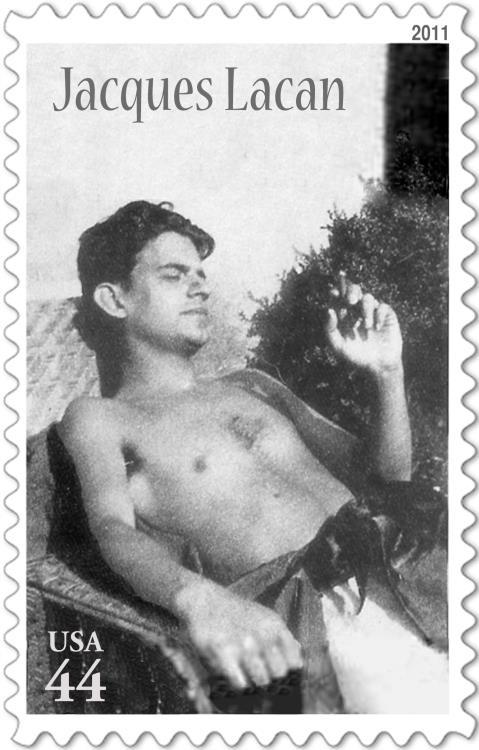
Now we can all possess his youthful, sexy, and diminutive body—shall we call him cutie-pie? We can gaze in admiration and give thanks for his (in)famous contribution to feminism.
And the best part?
There are now millions of him so you never have to go without.
41

42
ORLAN. The Origin of War. 1989. Aluminum-backed Cibachrome. 34 x 40 inches. 102.5 x 87 cm.
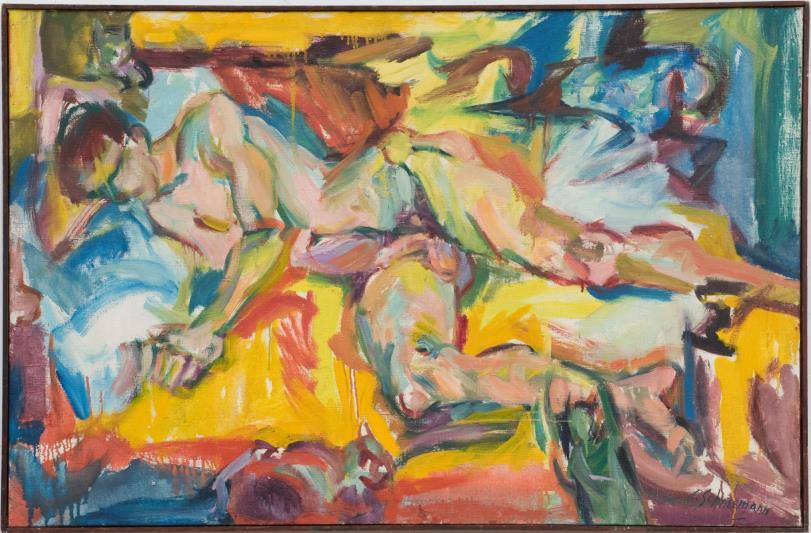
43
Carolee Schneemann. Personae: JT and Three Kitch’s. 1957. Oil on canvas.
31 x 48 inches. (Photo – James Dee)


44
Carolee Schneemann. Fuses. 1967. Self-shot film stills.

45
Carolee Schneemann. Portrait Partials. 1970; print edition 2004. Giclee print. 44x44 inches.
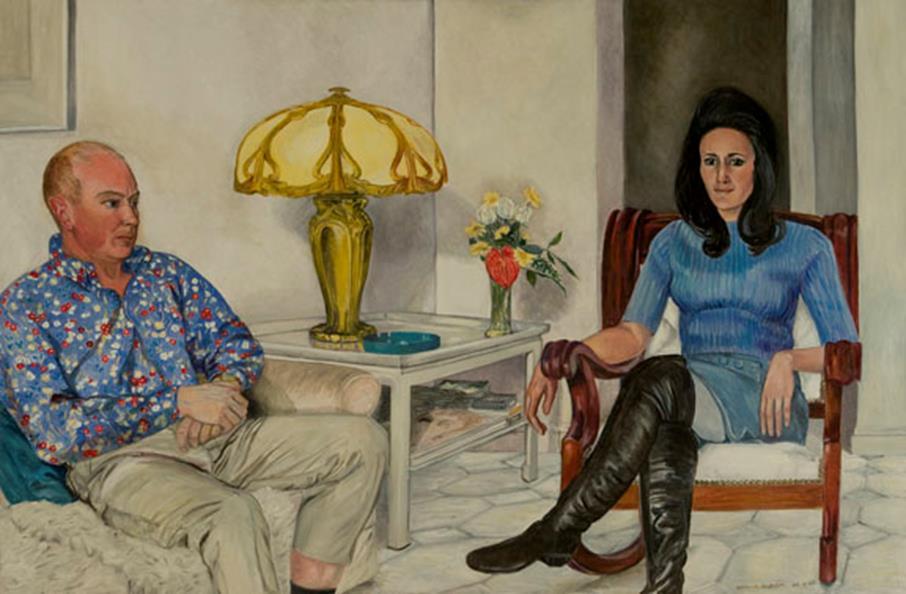
46
Sylvia Sleigh. Lawrence and Susana Delgado. 1968. Oil on canvas. 48 x 72 inches.
This piece was donated by the Estate of Sylvia Alloway (Sleigh) in collaboration with the Women's Caucus for Art to the Mills College Art Museum, September 2011.
ON SHOOTING MEN
Annie M. Sprinkle
From 1985 to 1990 I shot “spreads,” centerfolds and some covers for All Man and Friction magazines. These glossy color magazines were geared towards the gay men’s market. My editor Pat Reshen (a woman) would send me “models” who chose to be photographed by a female because either they were either heterosexual, bisexual, or gay men who didn’t want to deal with a male photographer coming on to them. My monthly deadlines coincided with my menstrual cycle.
THE SET UP
The “Sprinkle Salon,” my photo studio, was in my cozy Manhattan apartment at Lexington and 27th street. When I had a “shoot” I’d shove my living room furniture into the hallway, hang a backdrop, and set up my Speedatron strobes. As the photographer I got paid $300 to $500. The model got $150 to $200. It was always nice to get paid more than a man for basically the same amount of work—and I wasn’t even the one taking my clothes off.
Before a shoot I would speak with my prospective model by phone in order to come up with some concepts. I’d find out what their actual hobbies/ interests were, and what costumes and props they could provide. It was important to me that he loved the photos as much as I did, so I liked to portray a man as he wanted to be portrayed. Never did I ask
someone to do anything that I hadn’t done. I had posed for many sex magazines myself. Many of my models had seen me naked before we even met.
Shooting a naked man was a relatively enjoyable way to spend an afternoon or evening, never a chore. Sex and creativity are a great combination virtually the same thing. However, it was hard work. A shoot would usually last four or five hours and I would expose on average eight 36-exposure rolls of film.
Guys who came into my studio knew the score. They were expected to have an erect penis in all the magazine photos. This meant I would photograph a man stroking his cock for several hours, minus tea and cigarette breaks. I’d supply the massage oil for him to oil up his penis and anus, which made the “naughty bits” sexier, and pick up highlights. I was never shy to get right up close to an erect penis and I had no qualms about telling a naked man what to do. My requests were seductive, peppered with compliments. “Can you squeeze your buttocks? That looks hot! Cheat your handsome face to the light and look right into my lens. YES! Hold your cock firmly now. Great stuff. Yes! Yes! Ohhh, that’s good! Your balls look really incredible right now. I love that angle. Wow!…” And so it went.
My models were always polite, friendly and professional. If a model wanted to flirt with me, I would flirt back. If they didn’t, that was fine by me. Either way worked.
47
SELECT SHOOTS
Scott Irish was a rare gay porn star because he was a genuine red head his carpet matched his drapes, as they say. I put him on my exercise ball and got some great shots of his hard-on through his exercise shorts with a nice pre-seminal-fluid wet spot. Then had him lay down on brown satin sheets, which looked great with his red hair and fair skin. Akira was also a rarity, at least in the USA he was a Japanese porn star. For his shoot, I bought a relatively pricey, colorful plastic swimming pool mattress for him to pose on. A few days later, I was able to return the mattress for a full refund. A girl had to do what a girl had to do.
Being on a tight budget I tried not to spend too much money on props and sets but use what was available. I snapped Rick Savage straddling my blue mountain bike with his hard cock resting on the phallic bicycle seat. Cory Monroe was a nursing student so I had him lay across my sturdy old wooden desk wearing only a stethoscope. To make his cock close ups more distinct, I slid some yellow #2 pencils into his pubic hair. For Rick Donovan, a famous gay porn star, I took advantage of the morning sunlight coming through my Venetian blinds, positioning him in a chair so the stripes of light hugged his manly body. Rick D. had an awe-inspiring, humongous penis! So I highlighted his intellect by shooting him reading The New York Times. After all the rolls of film were exposed, Rick D. came on to me hard and heavy. I wasn’t a size queen honest but we had a sizzling erotic connection. So in the heat of passion we fucked without a condom. I was mad at myself for that. When I got tested for STDs I was fine, but sadly his brother, porn star Casey Donovan, passed away from AIDS a few months later.
For years I’d had the hots for underground filmmaker Nick Zedd and was thrilled to get him in front of my big hard lens. For his super-sized cock to get fully engorged, he jerked off to VHS videos he had brought of women wrestling. That was a bit strange, but my photos of Nick Zedd are perhaps, for me, the sexiest of all. Then there was Keith Ardent who was big into characters and brought loads of costumes. We shot him as a sailor, jocky with riding crop, waiter serving martinis, superhero, sports jock, and more. He embodied the entire Village People in one fell swoop.
There were definitely a few models with whom I absolutely did not encourage an erotic connection, like when they were the boyfriends of my girl friends. Akal was the blonde German boyfriend of my tantra teacher, Jwala. He was desperate to make some money to buy a plane ticket to India to be with his guru, Rajneesh. He virtually begged me to shoot him, but I always felt a little weird about it, because Akal wasn’t the kind of guy that would have wanted to be in a gay men’s magazine, unlike my other models who were more than happy to be. Thomas Williams was my best friend Veronica Vera’s boyfriend. His professional porn name was Joe Simmons, and he was a gorgeous, black Mapplethorpe model. Thankfully Joe didn’t make a pass at me, because in this case I would have had to say “no.” I had my boundaries.
Some men I photographed were my lovers before they were my models. Roger Koch, aka Frank Vickers, also a Mapplethorpe model, was a body builder with a taste for kinky sex. Four times I photographed Roger for four different spreads, one of which was with his body builder buddy, Rocco. Photo shoots were a part of our sexy fun and we
48
always enjoyed “working” together. David Sandler and I met when I cast him in a video I wrote and directed for the first feminist porn company Femme Productions, created and run by my dear friend Candida Royalle. In 1987 the movie was released as Rites of Passion—In Search of the Ultimate Sexual Experience.
David was fabulous in it. He was a juggler, an acrobat, very Jewish, and very spiritual. After the movie shoot, David and I enjoyed a month of magnificent lovemaking, as we were both versed in tantric and taoist sex practices. After he posed for an All Man magazine spread and cover for me, that night I really wanted to make love with him. I was falling in love with him. But he wasn’t falling in love with me so he broke up with me. I was crushed but moved on. I became a lesbian.
fact, Johnny invented the term “drag king.” Groups of women would come through my apartment every few weeks and be transformed into men. Sometimes I would join in the fun and got transformed into a man of one sort of another myself. When my heterosexual friend, artist Katharine Gates wanted to explore her inner male archetypes we made it into an art project. Johnny did her facial and chest hair and other make up, and with the use of costumes and lighting, and we created The Seven Men Inside Katharine Gates (1990). It’s one of my favorite pieces, and with megastar Lady Gaga doing drag king performance now (2011), it’s pretty herstoric. We have come such a long way.
PROCESSING
GENDER EXPERIMENTS
Exploring gender was one of my favorite themes. Once I stuffed buff body builder Roger Koch into a teeny tiny pink female g-string with feathers on it, a comment on butch-femme. In 1988 I had a female to male transsexual lover, Les Nichols. For a shoot I dressed him up in full female drag with corset, wig and high heels, and turned him into a F2MTSM2FTV (Female to male transsexual male to female transvestite) for a shoot. It was fascinating and thrilling to see a woman who had become a man become a woman again before my very eyes. He was such a good sport, and for a bearded man, he sure could work high heels.
In 1990, my friends Diane Torr (a performance artist) and Johnny Science (an F2MTS musician) taught the first “drag king workshops” at the Sprinkle Salon. In
My favorite film was Kodachrome, because the color really popped, and it gave skin a warm glow. The problem was that only Kodak could process Kodachrome, and in those days if Kodak found any nudity at all it would confiscate and destroy all of your slides. To get around that, there was a guy named Mark who worked in the lab after hours. He would make the rounds of all the sex magazine offices to collect the film, process it, then he delivered the processed slides the next day. He had a booming business. Slide editing would take me a couple of hours. I would work on a light box and throw away about two thirds of the slides, keeping only the best shots. When the magazine was done with the slides, they would give them back to me. When requested, I always gave my models some slides. Then I’d file the slides away along with the ever-important signed model release. In those days we didn’t need a copy of a photo ID to prove a model’s age, like now. But my models were certainly all of legal age—over eighteen.
49
It was exciting to get the magazines with my printed photos in the mail, and see them on the newsstand, even though the editor rarely seemed to pick the shots I would have picked. Sometimes the photos were credited with my name, Annie Sprinkle, and other times Pat wanted to cover up the fact that I was female so we used my gender-neutral name, “Top Chakra.”
IS IT ART OR IS IT PORN?
Sometimes I had the urge to make some of my sex magazine photographs into art projects. These would show, and sell, at art galleries and international art fairs. My Teeny Tiny Big Black Dick sold out the edition of ten. Anatomy of a Pin Up was bought by some major collections, and currently is showing at the prestigious Annenberg Place for Photography (May-November 2011). Some pieces found their way into art magazines and catalogues. My Bosom Ballet piece is on several book covers and the large print version hangs in a five star hotel, 21c, in Lexington, Kentucky. The series of over one hundred large format (20” x 24”) Polaroid transfers I made from my slides are now mostly all sold out and hanging in good homes.
For me, there were two major differences between porn and art: their contexts and their audiences. For myself, I made porn because it paid my bills, and because I had a strong creative impulse to do so. I followed my muse and my clit. Porn was meant for people who wanted to get turned on and get off. The art was for people who I imagined wanted to have their intellect stimulated, their imaginations fired, their funny bone tickled, or their politics aroused. In other words, the art I made was more of a social commentary about sex. The porn I made was for sex.
To generalize, I see art as for a more educated, higher income, intellectual demographic. I see porn as a sort of folk art, by the people for the people.
So what about “the gaze?” Sure, I shot my naked men with a “female gaze,” but also with a “gay male gaze,” as I was heavily influenced by the gay men’s magazines I shot for, and also by Robert Mapplethorpe. But then perhaps Robert Mapplethorpe was influenced by some of my photos in All Man and Friction?
IN RETROSPECT
Looking through my now post-menopausal eyes, and after being in a wonderful, eleven year relationship with a woman, artist Elizabeth Stephens, the days of photographing dozens of naked men with hard-ons seems like a distant, weird, erotic dream. Was that really me? Thankfully I still have the tear sheets to prove that it was very real, and it was me! Certainly I am a different woman now. When I “yesterbate” (as my friend Kembra Pfahler calls it) about all this, I feel sad because so many of the men I shared this history with are dead and gone from AIDS and cancer. But more so, I swell with pride, smile inside, and get a big heart-on.
50
-up by Johnny


In 1990 the first "drag king workshops" took place in my Manhattan apartment with Johnny Science and performance artist Diane Torr. Johnny Science, an F2M pioneer, invented the term "drag king." He had learned how to use make up to pass as a man. Often I would take some photos at the workshops. Artist Katharine Gates, was interested in exploring her inner men. So she and I put together a three day shoot. I did the photos, Johnny did the make up, and Katharine was our clay. Here are the results.






51
Annie Sprinkle. Katharine Gates, model/collaborator. The 7 Men Inside Katharine Gates. 1990. Photography. 15 x 57 inches. Make
Science.
Jimmy Cross
Edwin Rochester, III
Patrick O’Sullivan
BuddyVegas
BillyJoeFreeman “Uncle” Happy “Bubbles” Galore
Katharine Gates

52
Annie Sprinkle. Teeny Tiny Big Black Dick. Model: Joe Simmons, aka Thomas Williams. 1990. Photography. 1 x 3/4 inches. (Framed and matted, 16 x 12 inches.)
Elizabeth Stephens is a performance artist, activist and educator whose visual art, performance art and writing have explored themes of queerness, feminism for over 25 years. Back in 1992 for her MFA show Stephens parodied the pornographic “male gaze” with her photographic series, Who’s Zoomin’ Who? Currently she is creating a new field of research in collaboration with her partner Annie Sprinkle. They call this field SexEcology. Together they are attempting to make the environmental movement a little more sexy, fun and diverse by exploring the space(s) where ecology and sexology intersect. SexEcology embodies the art of exploring the Earth as a lover instead of as our codependent and depleted mother. As a long-term lover of the Appalachian Mountains Stephens is working to end mountain top removal coal mining in her home state of West Virginia.

53
Elizabeth Stephens. Ron Jeremy's BVDs. 2008. Bronze Sculpture. 7 x 2 x 5 inches.
May Wilson (1905-1986). Untitled. 1965-1972. Collage. 10 5/8 X 7 7/8 inches. Courtesy Pavel Zoubok Gallery.

54
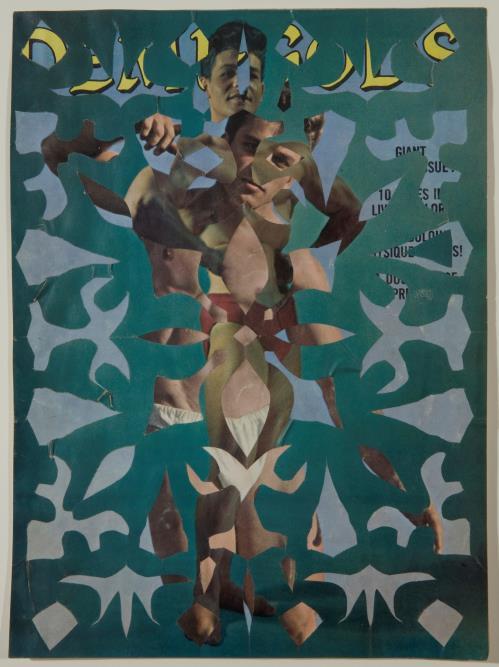
55
May Wilson (1905-1986). Snowflake (Demi Gods). 1965-1972. Collage. 10 5/8 X 7 7/8 inches. Courtesy Pavel Zoubok Gallery.
THE ETHICS OF THE FEMALE GAZE—THE “SEX” ACT OF A WOMAN BEHIND THE CAMERA
Society has constantly signaled the imperative of male sexual dominance. I suggest the main offense or discomfort committed by a sexualized "female gaze" is the disruption and transference effected by the reversal of this received view as to what an eroticized images should portray. Men are commonly and “classically” viewed as the hunter not the prey. A woman "shooting" a naked male with a camera (terminology used for taking a picture as a metaphor for pulling the trigger on a gun) assumes the position of penetrator in the sexual act, and the male becomes the “penetrated.” In the aesthetics of the erotic heterosexual, it is the female who is assumed to be vulnerable, not the male. The surveillance of the male as subject of female pleasure is an interpellation of the core the patriarchal structure.
In classic Hollywood cinema the "female gaze" is mostly designated as having negative connotations. Time and time again when a woman "goes after" an attractive male (her gaze sexually objectifying the male) events always go badly for both female and male subjects in the narrative. To name just a few, Double Indemnity, Hollywood Boulevard, The Postman Always Rings Twice, Detour and The Lady from Shanghai. A more subvert example of the totality of the male gaze is the film Casablanca mirrored by events occurring on and behind the screen. In the film, directed by Michael
Curtiz (with screenplay by the Epstein brothers) the “object of the gaze” is the heroine (performed by Ingrid Bergman) and the rivalry between the two male characters vying to ultimately possess her. Bergman, who was at the time “under contract” to the producer David Selznick, is quoted, “he rented me out to other studios.” When Selznick “offered” Bergman the role in Casablanca (and with a script yet written) she commented “You cannot sell me for something when you don’t know the story.”1 The male dominion and possession of the woman as “performer” is thus completed in both the screen image and in reality.
Though the tides of the “gaze” in Western culture seem to be shifting, with the west leading the charge of permitting a more dominant female view, not only in sexual paradigms but of the world at large to suggest beyond the “gaze” if history is to be any lesson, perhaps we should be cautious about promoting the dominance of any one sexualized gendered view. In a recent "real" example of the currency of the "female gaze," Julian Assange (founder of Wikileaks) was quoted in an interview, that a "trophy photo" of him "lying naked in her bed," was taken by one of the Swedish women who later pressed charges against Assange for unwanted sex (sex without a condom).2 Perhaps we should exercise an attitude of deference towards the "power" of the camera?
Melissa P. Wolf, one half of the collaborative art partnership EIDIA.
Wolf has worked with Paul Lamare since 1983 with the making of The Chelsea Tapes (1983-1984).
56
1 Richard J. Anobile, ed., The Film Classic Library Casablanca (New York: Darien House, 1974), 5-6.
2 Marie Colvin, “Wikileaks Founder Baffled by Sex Assault Claims,” The Australian.com (27 December 2010). http://www.theaustralian.com.au/indepth/wikileaks/wikileaks-founder-baffled-by-sex-assault-claims/story-fn775xjq-122597645928



57
Melissa P. Wolf. M. Ode to Fritz Lang Redux. 2011. Giclée photograph printed on archival Canson Baryta museum paper, edition of 10, (with 2 AP), signed & numbered verso. 17 x 22 inches.
58
Leslie Aguillard, Mel Ahlborn, Roberta Ahrens, Olga Alexander, Sharon Allicotti, Zina Al-Shukri, Carolyn
Applegate, Juliane Backmann, Hazel Bartram-Birchenough, Joanne Beaule Ruggles, Jasmine
Begeske, Erica Bendickson, Susan Bennett, A Binghamfreeman, Erika Brooks, Tracy Brown, Reena
Burton, Della Calfee, Brie Castell, Claudia Chapline, Yuling Chuang, Christine Cianci, Janie Cohen, Katie
Commodore, Nicole Craine, Tristan Crane, Tristan Crane, Arabella Decker, Deena des Rioux, Rosemary
Giusti Dillon, Liz Dodson, Eileen Downes, Betsyann Duval, Merrilyn Duzy, Fran Eber, Roya Farassat, Sheila Finnigan, Lin Fischer, Eileen Fitz-Faulkner, Julie Fournier, Sandy Frank, Lynn
Friedman, Linda Friedman Schmidt, Margaret 'Margo' Garces, Michal Gavish, Judy Gelles, Ingeborg
Gerdes, Christine Giancola, Lisolette Gilcrest, Sarah Beth Goncarova, Pallavi Govindnathan, Chanel
Matsunami Govreau, Corinne Greenberg, Gail Gurman, Karen Gutfreund, Tania Hammidi, Valerie
Hallier, Sharon Hart, Laura Hartford, Trudi Chamoff Hauptman, Lidia Hasenauer, Marlene Hawthrone
Thomas, Deena Haynes, Karen Henninger, Katty Ryan Hoover, Hedda Hope, Aisjah Hopkins, Sara Hopkins, Cynthia Horn, Tedda Hughes, Birgit Huttemann-Holz, Annette Isham, Patricia Izzo, Lahib
Jaddo, Ellen Jantzen, Annelise Jarvis-Hansen, Elaine Jason, Tammy Kinsey & Jean Kusina, Judy
Johnson-Williams, Tamarra Kaida, Ashley Kauschinger, Christy Kelly-Bentgen, Elizabeth Kendall, Ellen
Kieffer, Karen Lance Klaber, Corlia Kock, Susan Kraft, Diana Krevsky, Beth Lakamp, Sarah Lapp, Lark, Allison Leach, Evie Leder, Lee Lee, Sharon Leong, Lynn Elliott Letterman, Amelia Lewis, Lory Lockwood, Kelsey Livingston, Michelle Lopez, Jacalyn Lopez Garcia, So Yoon Lym, Cat Lynch, Sita
Mae, Kelsi Mannhalter, China Marks, Louise Maloof, Kristina Martino, Karen Mathews, Jeanette May, Kristine Mays, Shilo McCabe, Alysanne McGaffey, Harrigan McMahon Bowman, Erika Meriaux, Carol Morris, Amy-Elyse Neer, Jill Nonnemacher, Barbara Neri, Janice Nesser, Nancy Netherland, Molly Marie
Nuzzo, Brenda Oelbaum, Beth Olds, Colleen O'Donnell, Priscilla Otani, Jacki Orr, Arla Patch, Nancy
Peach, Rachael Perisho, Heather Pilapil, Karen Purdy, Xian Mei QIu, Patricia Quilichini, Nora Raggio, Cherie M Redlinger, Lynda A. N. Reyes, Trix Rosen, Judith Roth, Laura Rusnak, Carla Sanders, Loredana
Sangiuliano, Clara Saprasa, Elinore Schnurr, Centa Schumacher, Judith Segall, Shizue Seigel, Sal Sidner, Sarah Sipling, Bonnie J. Smith, Priscilla Smith, Madelyn Smoak, Jenny Snyder, Julie Snyder, Elizabeth
Sowell-Zak, Susan Spaniol, Colette Standish, Julie Sutherland, Erika Swinson, Yuriko Takata, Lani
Tanaka, Patricia Terrell-O'Neal, Deborah Mills Thackrey, RoByn Thompson, Lynne Todaro, Linnea
Tober, J Toffic, Mette Tommerup, Cristina Velazquez, Christina Renfer Vogel, Susan von Gries, Alexandra Walker, Theresa Walloga, Ruth Waters, Jennifer Weigel, Susan Weisberg, Rachel Weissberger, Carolyn Weltman, Ellen West, Corinne Whitaker, Tamara White, Melissa Wilkinson, Sheila Winner, Kathryn Wood, Carol Witten, Jan Wurm, Jenny Wrenn, Nanette Wylde, Marian Yap, Kathleen Yorba, Emily Yost, Karen Zack, Lucia Znamirowski * denotes artists in SOMArts Cultural Center Main Gallery
59
Objectifying Man, the male gender, the male sex. Quite a turn, as it would be for a bear or a shark, top of the food chain, fearing nothing, to somehow be convinced to peer into a mirror and question themselves in any way at our request.
To those few men who protest that they indeed recognize their feminine sides, love their wives, respect and honor the other half of humanity, and feel sorrow for the millennia of subjugation, rape, terror, and degradation done to women, all I can say is: I feel your pain, but we still need to say what needs to be said. I am not here to champion anyone’s politics. I am not saying that all is well. I am here to speak my piece, and my peace. I mourn many friends (male and female) now gone from this life as precious and irreplaceable treasures. Politics mitigate nothing. We do not have an IV that infuses either experience or perspective into the veins of anyone, young or old. There is no substitute for the wisdom born from the pain of having made wrong decisions.
Leslie Aguillard. Sometimes a Cigar is Only a Cigar. 2011. Paper mache and rabbit fur. 10 x 7 x 3 inches.
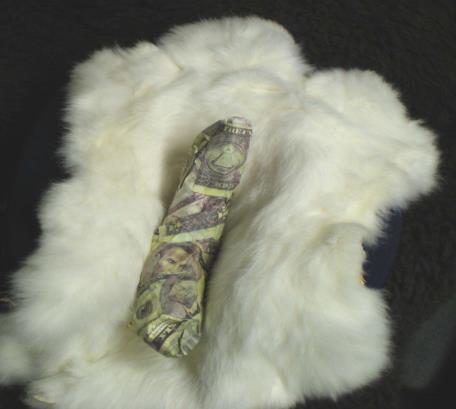
We need each other to survive. We complete each other. We are made for each other. We are both creaturely and divine, made of the same elements as the stars. We have the sublime potential of the greatest art and acts of heroism ever conceived, and likewise can be as cruel and insane as any can imagine. Some call it "human nature" – but I think we have been following misguided interpretations of how life must be. We cannot change what has gone before, but it does not have to be this way anymore. We have the power of choice.
We do choose, to love, hate or ignore. We choose to be kind, patient or to disregard any but our own animal senses and momentary desires. We choose to cooperate or to instigate barriers and betrayals. We choose everything we do. I spent many years doing things I did not want to do, but nevertheless, I am here today.
I am an artist and a teacher, a musician and singer; a registered nurse; a seminarian and ordained minister; a Reiki master and a black belt in Aikido; a cancer survivor; volunteer passing out dinners; been abused, applauded, published and still have laughed, and want to laugh more. I want to make my art and keep those things I do not want to do to an absolute minimum. I want to be a part of that which is greater than a self, and I want what small part of the world that knows of me to be able to say, “yeah it is better because of her.” Will that happen? I don't know. None of us knows. But together, we can get there to that better place. Together we can laugh, love, build, and reform. Together we hold a mirror up to the other and request an audience, a moment of reflection, and consciously choose.
Leslie Aguillard
60



61
Mel Ahlborn. Cathouse - Appetizer. 2011. Oil on canvas. 30 x 30 x 1.5 inches. *
Mel Ahlborn. Cathouse - Entree. 2011. Oil on canvas. 30 x 24 x 1.5 inches.
Mel Ahlborn. Cathouse - Dessert. 2011. Oil on canvas. 30 x 10 x 1.5 inches.
I was always fascinated by De Kooning's Women series and how these paintings walk a fine line between the grotesque and the cartoony. With the Man painting I explore the male figure as protagonist for action and virility and in a humorous way; I poke fun at cultural practices that privileges males as the default setting in all things. Olga Alexander
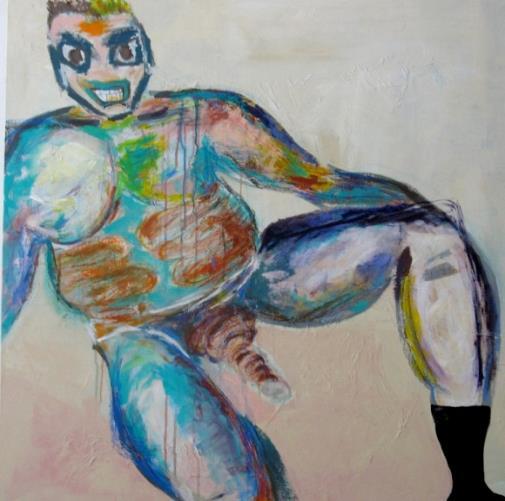
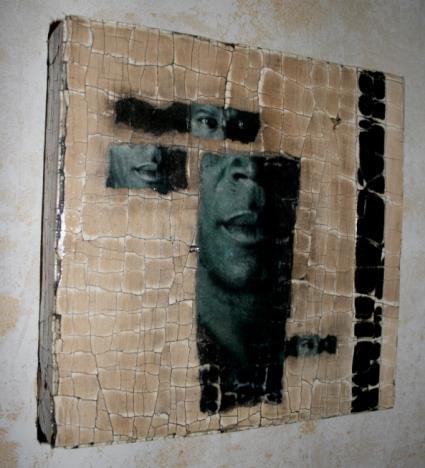
62
Olga Alexander. Man. 2011. Acrylic, gouache and colored pens on canvas. 36 x 36 inches. *
Roberta Ahrens. Blend. 2010. Painting on handmade cracked linen. 12 x 14 inches. *
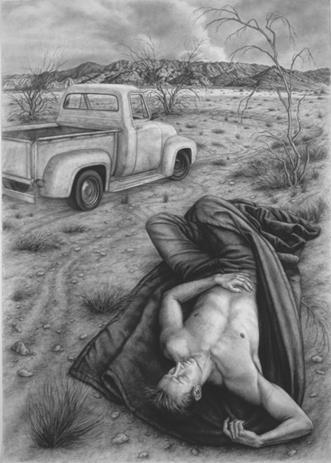

63
Sharon Allicotti. Slumber at Chuckwalla Valley. 2004. Charcoal and crayon on paper. 41.5 x 29 inches.
Sharon Allicotti. Rear Window. 2001. Pastel on paper. 22 x 46 inches.
Women want to retaliate against the unjustness that has been consistently bestowed upon us by a certain population who just can't seem to govern their sexual propensities. Far too long, men have been governing female bodies and women have allowed this. When I look at objectified people I see a certain element of desperation or an untraceable absence from that person. These paintings attempt to envisage the sexual objectification of men on a visceral and philosophical level and convey ideas of imbalance and uncertainty.


64
Zina Al-Shukri. Look Into My Eyes. 2010. Gouache, charcoal and gesso on paper. 34 x 48 inches.*
Carolyn Applegate. Menage a Trois. 2011. Fabric, polyfill stockings. 26 x 10 x 8 inches.
Zina Al-Shukri
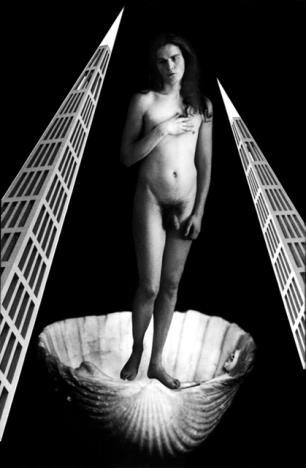
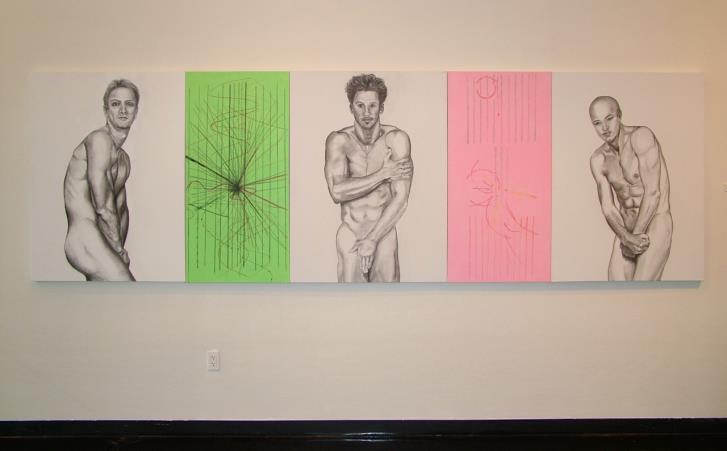
65
Juliane Backmann. Venus. 2011. Lambda print. 30 x 20 inches. In collaboration with Mirgana Kling. *
Hazel Bartram-Birchenough. Anatomic Series 1. 2010. Conte, charcoal and acrylic on canvas. 4 x 13 feet. *

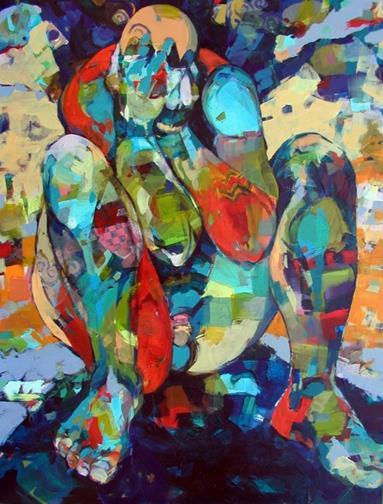
66
(left) Joanne Beaule Ruggles. The Sorrow of Man I. 2000. Acrylic on canvas. 40 x 30 inches.
(right) Joanne Beaule Ruggles. A Loss of Something Ever Felt I. 1995. Acrylic on canvas. 48 x 48 inches. *
Jasmine Begeske. In Hand. 2009. Digital archival print. 4 x 4 inches.
Jasmine Begeske. Window. 2009. Digital archival print. 4 x 4 inches.
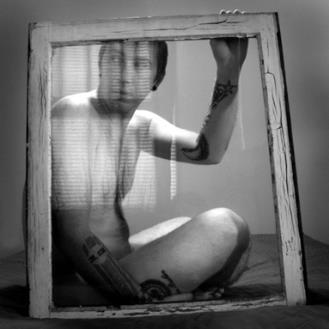
Jasmine Begeske. Lay. 2009. Digital archival print. 4 x 4 inches. *


67


68
Erica Bendickson. Suspension in Pink and Green. 2011. Pink Post-It Notes, oil paint on canvas and wall. 5 x 5 feet.
Susan Bennett. Untitled 2. 2009. Mixed media. 7.5 x 8 x 2 inches.
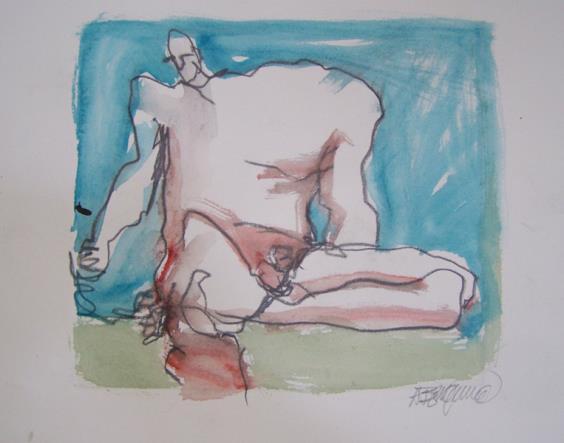
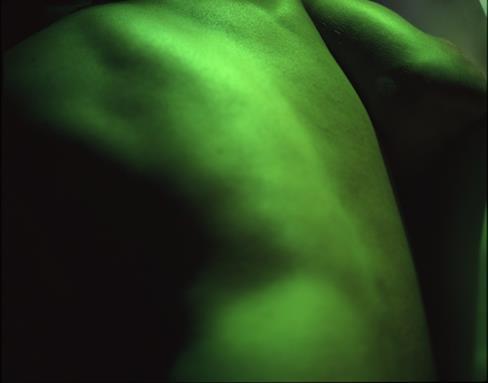
69
A. Binghamfreeman. Man Drawing. 2011. Paper, graphite. watercolor. 11.5 x 12 inches.
Erika Brooks. Bodyscapes #13, 2001. 2001. Rag paper. 16 x 20 inches.
B-a-n-a-n-a-s is an ode to Linda Nochlin’s 1972 Buy My Bananas and the achievements of similar female artists of that time. During the same era, Andy Warhol created his famously mass produced 1966 Banana. Unlike many of their male counterparts, however, female artists have largely remained in the shadows of history. Bold and eerily playful, B-a-n-a-n-a-s reverses the gaze and are intended to create a dialogue on continued inequalities throughout the art world.
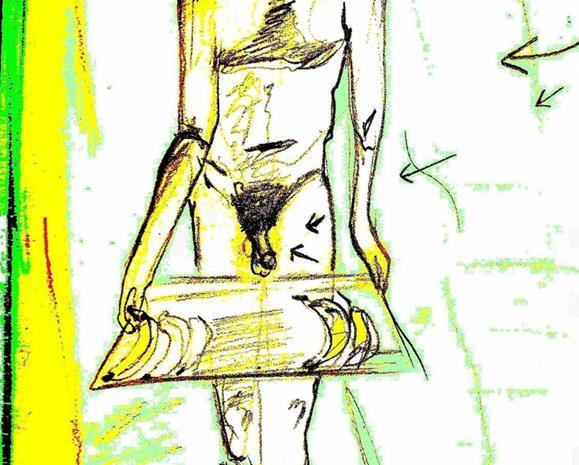 Tracy Brown
Tracy Brown

70
Tracy Brown. B-A-N-A-N-A-S. 2011. Digital print. 12.5 x 12.5 inches. *
Reena Burton. Papa. 2007. Acrylic on canvas. 24 x 18 inches.
Inspiration came from the strong and beautiful Caryatid maidens forming the stone pillars in the Erechtheum temple in ancient Greece. Gender is reversed to suit the female artist's eye, and was created in response to a lecture on the topic of political correctness. Della

 Calfee
Calfee

71
Della Calfee. Ass Like That. 1992. Archival paper. 22 x 7 inches.
Della Calfee. Men As Office Desk. 1991. Archival paper. 14 x 11 inches.
Della Calfee. Men As Table. 1991. Archival paper. 11 x 14 inches. *
Brie Castell. Distinguishable Attributes, #1, #2 and #3. 2006. Silver gelatin contact print, selectively bleached and toned. 11 x 14 inches.*

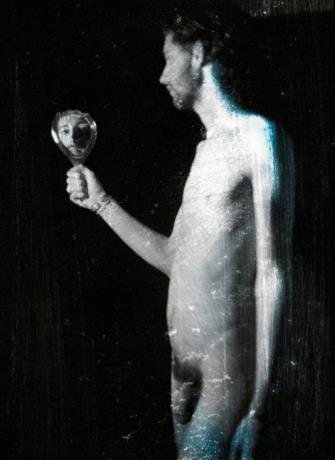

72

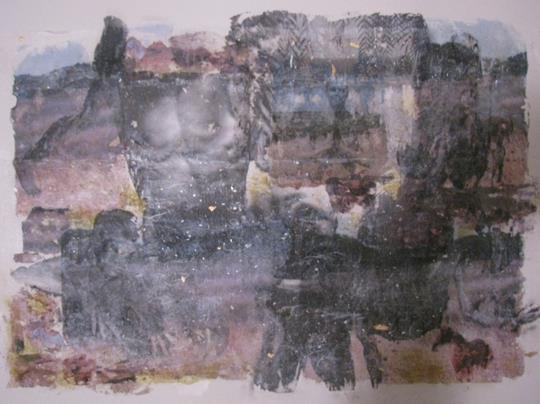
73
Claudia Chapline. Tyler's Tree. 2011. Charcoal and oil pastel. 24 x 19 inches.
Yuling Chuang. Manscape. 2011. Photo transfer, unryu paper and ink on watercolor paper. 24 x 32 inches.
Does objectifying the male in today's society defy conventional logic? Can society's conditioned mind to objectify females be defeated? Are the men depicted in my art fantasizing about women, or are the men objects themselves at which the female will gaze? My paintings of males caught in moments of time become koans. They do not tell the viewers of sexual objectification but can only give those viewers time to meditate and ponder the mystery of the queries.

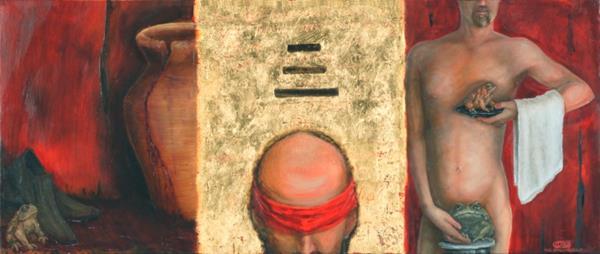 Janie Cohen
Janie Cohen
74
Christine Cianci. Toad. 2007. Oil and gold leaf on panel. 2 x 4 Feet. *
Janie Cohen. Song Sung Blue. 2010. Oil on canvas. 41 x 30 x 1.5 inches.

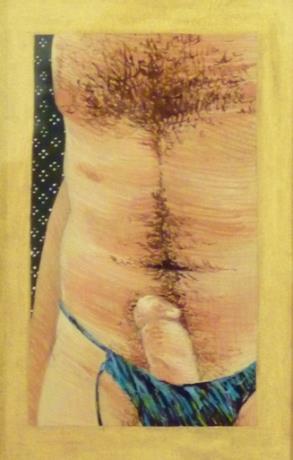

75
Katie Commodore. Greg, no. 1. 2010. Gouache and acrylic on paper. 22 x 30 inches. *
Katie Commodore. Greg, no. 2. 2010. Goucahe on paper. 7 x 5 inches.
Katie Commodore. Greg, no.3. 2011. Gouache on paper. 22 x 30 inches.


76
Nicole Craine. Bow. 2010. Archival pigment print. 20 x 24 inches.
Nicole Craine. Untitled Nude, 2010. 2010. Archival pigment print. 20 x 24 inches. *


77
Tristan Crane. Cassidy. 2011. Digital photograph. 20 x 30 inches.
Tristan Crane. Dex Hardlove. 2011. Digital photograph. 20 x 30 inches.
My goal as a photographer is to document the real, with the active collaborative participation of my subjects. My goal is to highlight the diversity of male beauty, identity, and sexual expression from the point of view of a queeridentified female person. I believe the male body is as much a thing of beauty as the female, in portraying it as such, I also like to hope we are helping to challenge a binary-gender concept of beauty. Tristan Crane
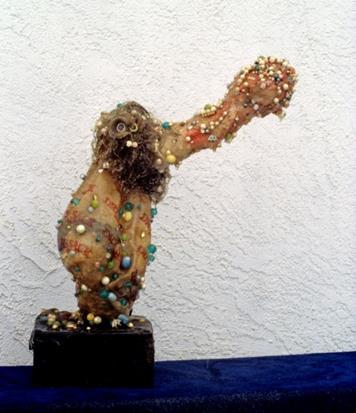

78
Tristan Crane. Quinn Valentine and James Darling. 2011. Digital photograph. 20 x 30 inches. *
Arabella Decker. Family Jewels. 2005. Mixed media sculpture. 10 x 7 inches. *



79
Deena des Rioux. DC-DC Converter. 2007. Photobased computer montage with scanned object. 45 x 42 inches.
Deena des Rioux. T-Blocker, Front View. 2000. Photo-based computer montage. 45 x 45 inches.
Deena des Rioux. Rotary Switch. 2002. Photo-based computer montage. 50 x 35.5 inches.
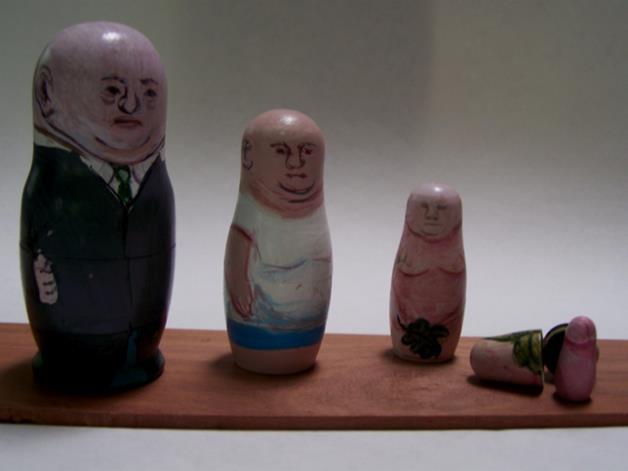

80
Rosemary Giusti Dillon. The Evolution of Man. 2011. Wood base, painted wooden nesting dolls. 6 x 10 x 4 inches. *
Liz Dodson. Men as Models: Madonnas and Child. 2011. Video, photos and text. 2 minutes 36 seconds. *


81
Eileen Downes. The X Man. 2009. Wax collage. 15 x 12 inches.
Betsyann Duval. Bodyscape #5. 2006. Oil pigment on plaster on wood panel. 48 x 48 inches. *
Duzy

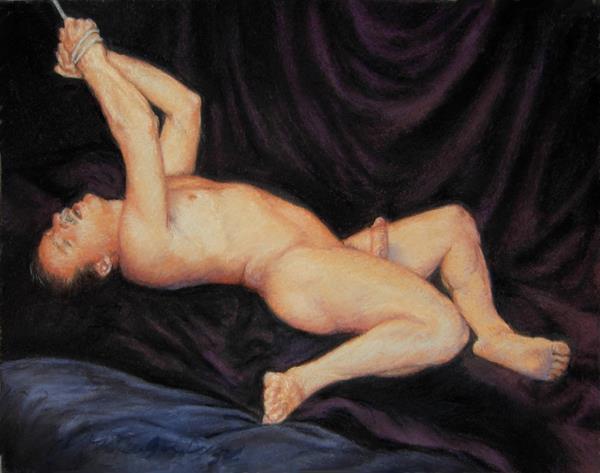
82
Merrilyn
. Bound. 2009. Pastel on Arches paper. 9 x 12 inches. *
Merrilyn Duzy. Repose. 2009. Pastel on Arches cover paper. 9 x 12 inches.


83
(left) Fran Eber. Snips and Snails. 2011. Digital photography on Epson Velvet fine art paper. 18 x 13 inches.
(right) Fran Eber. The Boxer. 2011. Digital photography on Epson Velvet fine art paper. 18 x 13 inches.
Roya Farassat. from the series, "A Mirror has Two Faces”. 2010. Acrylic on paper. 12 x 9 inches.
As a female born in Iran, I grew up in a tradition that embraced a distorted sense of reality, which has been a cause for social, political and religious hypocrisy. In previous work I made the image of a veiled woman to explore issues that focus on hidden identity, cultural ambiguity, suppression and sexual objectification. In a new series of portraits, I yield to a fascination with horror and despair to draw portraits of men who seem to be from the outer edges of society and who convey the idea of flaw, defect and eccentric. Roya
Farassat
Sheila Finnigan. A nose is a nose is a nose. 2011. Gouache and mixed media on paper. 30 x 22 1/2 inches.


84
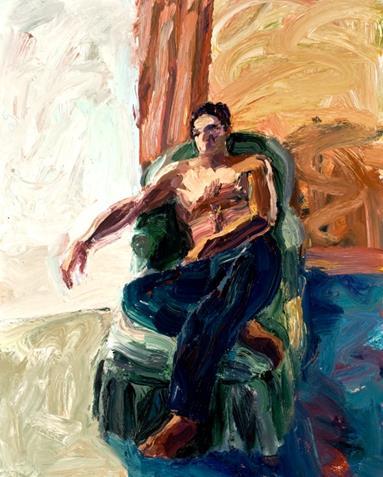

85
Lin Fischer. Man on Lounge. 2009. Acrylic on canvas. 60 x 48 inches.
Eileen Fitz-Faulkner. Man with Toolbox. 2011. Recycled lumber, steel, Acrylic and enamel paints, silk petals. 25 x 33 1/2 x 81 inches.


86
Julie Fournier. Light's On, SURPRISE!. 2010. Oil on canvas with doily. 34 x 17 x 1/2 inches.


87
Lynn Friedman. Bedtime. 2010. Canvas, pigment. 24 X 20 inches. *
Sandy Frank. Night & Day Man. 2010. Ceramic, paint, oxides. 18 x 13 x 4 inches.
Linda Friedman Schmidt. When Every Day Is Halloween. 2008. Discarded clothing. 27 x 32 inches. *
Margaret 'Margo' Garces. The Upper Hand. 2011. Watercolor on rag paper. 20 X16 inches.


88


89
Michal Gavish. Life Drawing on a Couch: Homage to Zigmund and Lucian. 2011. Watercolor on paper. 11 x 14 inches. *
Judy Gelles. Mid-Life . 2011. B&W photos and text panels. 36 x 93 inches. Courtesy of Pentimenti Gallery, Philadelphia. *


90
(left) Ingeborg Gerdes. Towel. 1978. Silver gelatin print. 20 x 16 inches.
(right) Ingeborg Gerdes. Hot Spring. 1978. Silver gelatin print. 24 x 20 inches. *

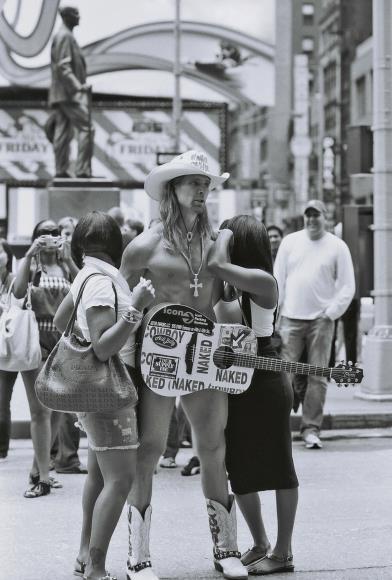
91
(left) Christine Giancola. Naked Cowboy, New York City. 2009. Archival digital print. 24 X 20 x 1.5 inches.
(right) Christine Giancola. Chelsea, New York City. 2009. Archival digital print. 24 X 20 x 1.5 inches. *



92
Lisolette Gilcrest. Sexy Bitch. 2011. Digital photograph with matte. 20 x 24 x 2 inches.
Lisolette Gilcrest. Raging Fan. 2011. Digital photograph with matte. 24 x 20 x 2 inches. *
Lisolette Gilcrest. Vulnerable. 2006. Digital photograph with matte. 24 x 20 x 2 inches.
Historical Inequality suggests a hypothetical archival finding which reveals a man in a Muslim veil implying the socio-religious norms that now exist upon women, once applied to men as well. It is an archive that questions male modesty, and the notions of oppression that is often judgmentally crafted by the West. An image made to inspire questions on culture, and the influences on history through religious manipulations for a global community and not merely people of that specific heritage. Pallavi
 Govindnathan
Govindnathan

93
Sarah Beth Goncarova. Torso. 2008. Oil on canvas. 20 x 24 x 2 inches.
Pallavi Govindnathan. Historical Inequality. 2011. Digital print. 8 x 10 inches. *
Chanel Matsunami Govreau. Hapa Bruthas. 2011. Performance, approx. 12 min.
A performance photo shoot. The artist photographs a Hapa male of roughly the same age while pre-recorded audio of the artist’s voice plays in the background.

The audio documents the artist discussing her experiences with Hapa male and Asian male sexuality in the context of family, white privilege, and romance. She explores the privacy of attraction, brotherhood, and interracial dating in Asian American communities from a multiracial Asian-American woman’s perspective.
The audience places the live interaction of the photographer and model into the context of the audio. Throughout the performance their possible relationship shifts between strangers, brother and sister, and potential lovers.
explores the absence of AsianAmerican male sexuality in popular culture as an issue that affects both men and women in communities of color including multiracial families and individuals.
is performance storyteller and costume designer who uses a combination of sculptural regalia and spoken word to create live narratives and collaborative photo shoots. Her stories are based on her activism as a queer, multiracial, and Asian-American woman. She investigates moments of vanity, emotional indulgence and self-exposure to extract and confront internalized social patterns.
94
These models were some of the most desirable I've worked with because of the ineffable quality of their spirit, their physical beauty, their ability to accomplish varied and creative positions and embody their poses with an essence of themselves. The gaze was a two-way street, a synergy where we encouraged each other with words and without. Because they were objects of my desire, it was not enough for me to describe their essence with the gesture of a line; I had to embellish.

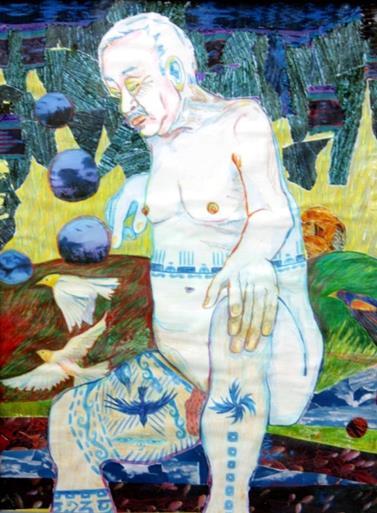
95
(left) Corinne Louise Greenberg. Yoshio Mundo Moviento En Un Tiento - In A Touch Yoshio Moves The World. 2009. Pencil, crayon, ink, paper collage on paper. 24 x 18 x 2 inches. *
(right) Corinne Louise Greenberg. Samauri Del Viento - Wind Samauri. 2009. Pencil, fabric, paper collage on paper. 24 x 18 x 1 inches.
Corinne Greenberg
What images come to mind when thinking of power, authority, and masculinity? How is masculinity defined in our patriarchal society? Patriarchal figures very often impart a sense of security with women. These archetypal men are perceived to comfort you, to keep you safe, to take care of you, and to keep order. They seem to embody the very definitions of power and authority. I observed and was taught from childhood that the world revolves around the power of men; it was only later that I questioned why. Why? Does the boys only club make you feel diminished and powerless?

 Karen Gutfreund
Karen Gutfreund
96
Gail Gurman. David. 2005. Oil on linen. 20 x 16 inches. *
Karen Gutfreund. Power Authority Masculine. 2011. Mixed media on canvas. 30 x 40 inches. *
This piece challenges the shame associated with imagining oneself outside (yet always within) the systems and circuits of surveillance which regulate masculine women. The image reflects my identities as a drag king, masculine model, and queer butch. While adopting stereotypical masculine cues in terms of dress and appearance in this portrait - short hair, suit, tie, no make-up, angles, and lines - I also challenge the masculinist project by introducing affect into the work. What might the smile be suggesting? To whom or what is it directed? In so doing, my intent was to lace the work with the kinds of questions about originals and copies which Judith Butler proposes in her writings on the performative. How does the gaze enter this work? Where is the original body? Which is the copy?

 Tania Hammidi
Tania Hammidi
In reference to photographic nostalgia, with this image I challenge the male gaze at the level of commodity and fantasy by foregrounding queer butch visuality and alternative modes of spectatorship. Casting not out, but diving into the visual trope of fashion advertising, the image is meant to blur the boundaries of "the real" and memory as a way of disrupting notions of truth, authority, and presence.
Tania Hammidi
97
Tania Hammidi. Look. 2011. Digital image. 10 x 12 inches.
Tania Hammidi. Mirrors of He. 2008. Digital image. 10 x 12 inches.
The installation portrays the men I've known and been most enamored with throughout my life, challenging the notion of attraction and romance by reversing the usual gender objectification. Each man is presented as a trophy or target, stylized with the decorative finish of a chrome effect and organized through a rating system defined by the traits of our relationship. While inviting the user to compare and evaluate the men, this display also offers the portrait of a contemporary woman through the objects of her affection. Valerie
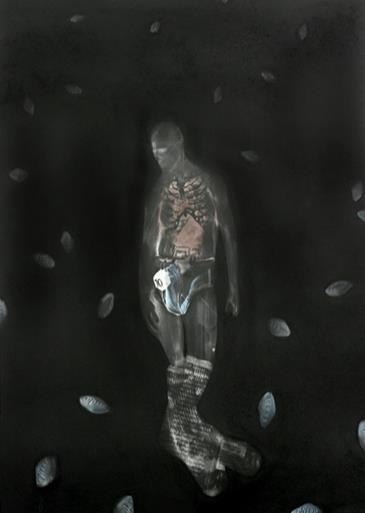
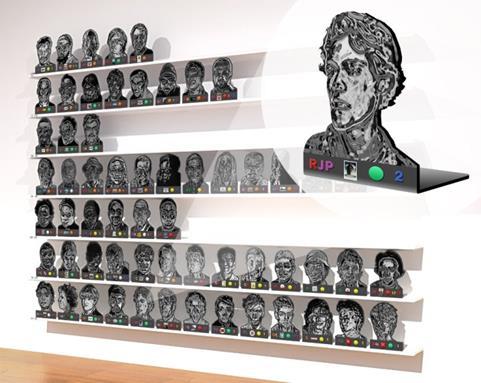 Hallier
Hallier
98
Valerie Hallier. The Males. 2011. Wooden shelves, cut/bended/printed metallic sheets. 10 x 20 x 0.8 Feet.
Sharon Hart. Researchers Still Double Blinded by the Benjamins. 2009. Inkjet print on Hahnemuhle paper with charcoal, color pencil, and graphite. 20 x 28 inches.
Acceptance of masculine beauty as an aesthetic theme fluctuates with changes in religion, politics, law and technology, and male artists have historically defined the standards of masculine beauty within art. My work explores the female gaze and questions the tradition in which, John Berger observes, “Men act and women appear.” I draw on Baroque and Victorian aesthetic traditions and am interested in the ways in which media, myth and popular culture assign gender identification to objects, gestures and the act of looking. Laura Hartford
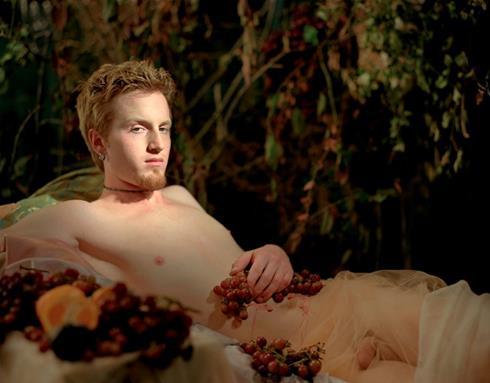

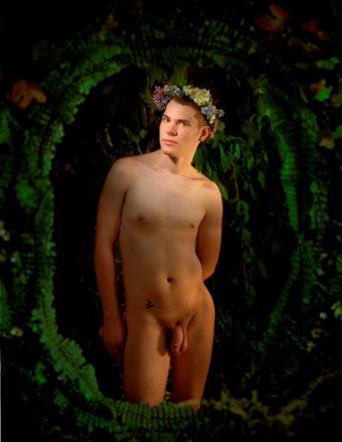
99
Laura Hartford. Adam. 2004. Color photographs, archival inkjet prints. 34 x 29 inches.
Laura Hartford. Eric With Flowers. 2004. Color photographs, archival inkjet prints. 34 x 29 inches.
Laura Hartford. Graham Reclining. 2004. Color photographs, archival inkjet prints. 29 x 34 inches. *
To “reverse the gaze” objectifies the male figure and makes it a spectacle for a woman’s enjoyment. In this feminist era women are free to purchase and possess the object of their desire without the attachment of the male personality or ego. It can be any size, color or material that pleases the woman. And she may have a variety to choose from on different occasions. This Special Occasion Box contains a very unique version. Trudi Chamoff Hauptman
Trudi Chamoff Hauptman. Only Open On Special Occasions.
2010. Fabric, lace, buttons, yarn, sand & poly fill beads.

12 x 6 1/2 x 6 1/2 inches. *
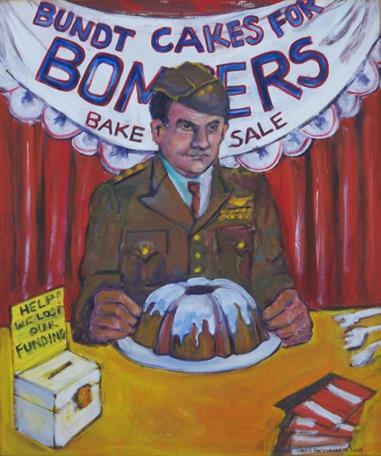
100
Lidia Hasenauer. Bundt Cakes for Bombers. 2005. Oil on canvas. 24 x 20 inches.


101
Marlene Hawthrone Thomas. (both) Untitled (from Study of Man Series). 2009.
Archival pigment print. 16 x 24 inches.
I have always been fascinated with how our culture identifies ideals of beauty within the female form. I photographed the male form in such a way that we can also appreciate the aesthetic quality and place it within a context that can bridge the human experience, regardless of gender—we all being forms comprised of blood, bones, sweat, and skin.

Marlene Hawthrone Thomas

102
Deena Haynes. Exposed. 2008. Digital photograph on Kodak metallic paper. 6 x 20 inches.
Marlene Hawthrone Thomas. Untitled (from Study of Man Series). 2009. Archival pigment print. 24 x 16 inches. *

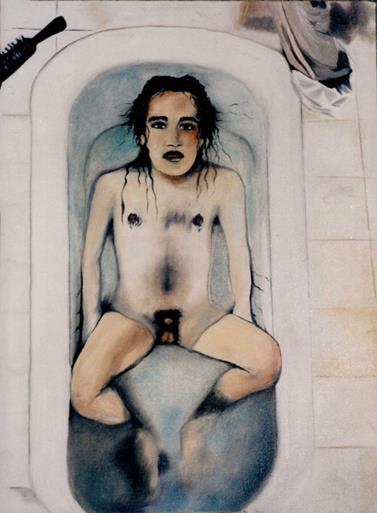
103
(left) Karen Henninger. Man in Tub. 1999. Oil on canvas. 24 x 18 inches.
(right) Karen Henninger. French Onion Soup. 1994. Oil on canvas. 20 x 16 inches.
Katty Ryan Hoover. Keith. 2011. Digital c-print. 34 x 40 inches. *

Hedda Hope. Frustration. 2005. Oil paint on stretched canvas. 30 x 24 inches.
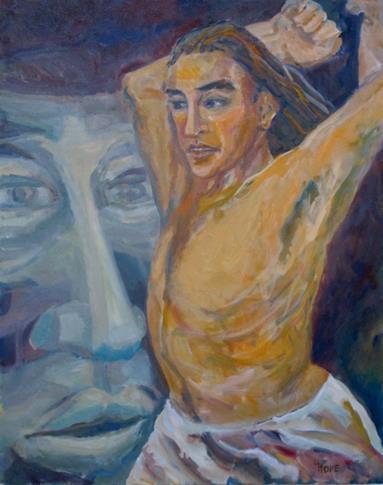
104

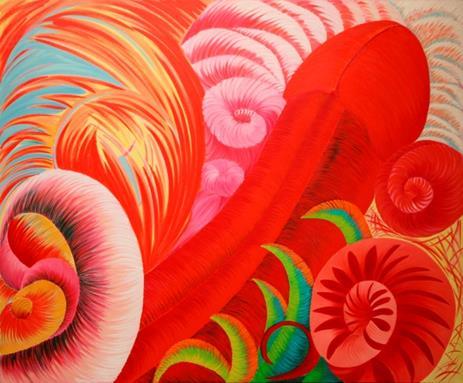
105
(left) Aisjah Hopkins. Agreement. 1987. Oil on canvas. 5 x 6 x 1.75 feet.
(right) Aisjah Hopkins. Contentment. 1987. Oil on canvas. 5 x 6 x 1.75 feet. *
Turn Over.


106
Sara Hopkins.
2011. Digital archival print. 16 x 20 inches.
Sara Hopkins. Spread Your Legs. 2011. Digital archival print. 16 x 20 inches.


107
Cynthia Horn. Livingston. 2009. Oil on canvas. 84 x 108 inches.
Cynthia Horn. Found. 2009. Oil on canvas. 60 x 72 inches.
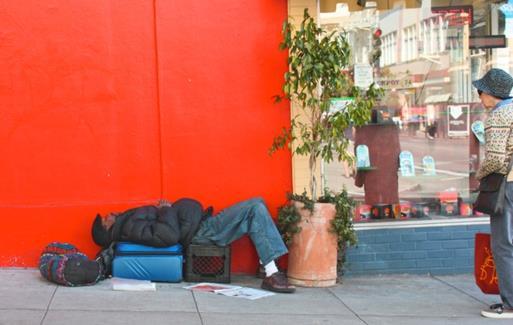

108
Tedda Hughes. Spare me. 2010. Photography. 16 x 20 inches.
Birgit Huttemann-Holz. Maennlich - Male. 2008. Etching on paper. 16 x 16 inches.
The image, One Night Stand reverses the common sexist occurrence that happens to women. Jokes are made about the one night stand/ female conquest with a wink and a nod in male circles. This image reverses the conquest by presenting the male for female pleasure, no strings attached. Creating sweet revenge and turn about fair play. Patricia Izzo
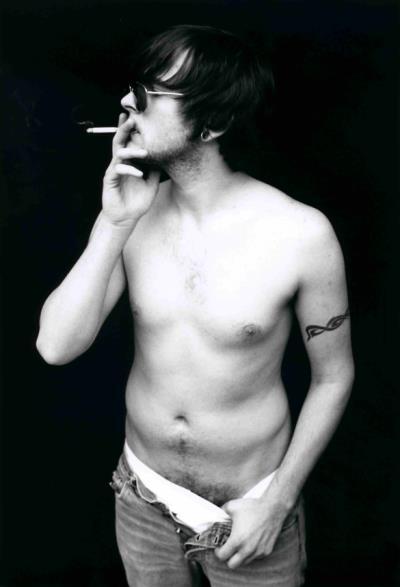

109
Annette Isham. The Gym. 2010. Video. 3:14 minutes. *
Patricia Izzo. One Night Stand. 2009. Archival artist canvas. 24 x 30 inches. *


110
Lahib Jaddo. Kareem. 2007. Acrylic and graphite on metal. 23 x 8 inches.
Lahib Jaddo. Open Chest. 2002. Acrylic on metal panel. 18 x 6 inches. *


111
Lahib Jaddo. Dark Night. 2002. Acrylic on metal. 12 x 18 inches.
Ellen Jantzen. Pleading Innocence. 2011. C-Print, Photograph. 36 x 24 inches.


112
Annelise Jarvis-Hansen. The Beautiful Hu-Man'. 2010. Drawing b/w. 16 x 12 inches.
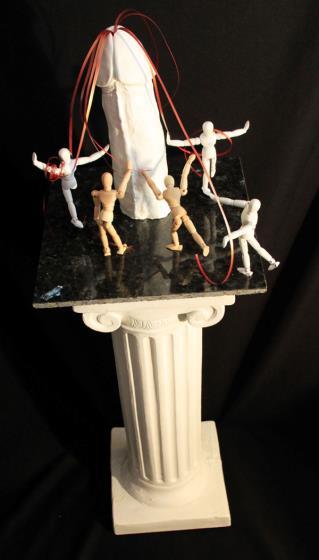

113
Elaine Jason. Ring Around the Maypole. 2011. Ceramic penis, ribbons, wooden mannequins on pedestal. 40 x 12 x 12 inches.
Tammy Kinsey and Jean Kusina. Packages. 2011. Digital video. 2.23 minutes. *


114
(left) Judy Johnson-Williams. With Hoodie. 2011. Colored pencil. 9.5 x 8.5 inches. *
(right) Judy Johnson-Williams. Eye-to-Eye with Willy. 2011. Colored pencil. 9.5 x 8.5 inches.

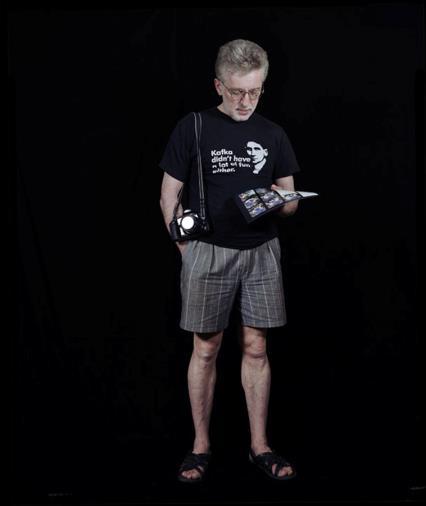
115
Tamarra Kaida. Dan Noel ( scholar/ writer). 1999.
Photograph. 60 x 39 inches.
Tamarra Kaida. Russian Photographer with Contact Sheet. 1999. Photograph. 60 x 39 inches.
A Series of Arches is the reversal of the lover’s gaze. There is a long tradition of males casting their eyes upon females: Steglitz, Weston, and so forth. I am not only revealing how a woman sees a man, but how a young woman sees a young man. There is a certain sensuality to youthful skin and eyes on the edge of adulthood. These photos are a brave exploration of sex and intimacy in a place of in between. Ashley



116
Kauschinger
Ashley Kauschinger. He Fell As Gently As A Tree Falls. 2010. Archival pigment print from a 4x5 negative. 20 x 16 inches.
Ashley Kauschinger. Small Exhausted Body. 2010. Archival pigment print from a 4x5 negative. 20 x 16 inches.
Ashley Kauschinger. I Said Nothing. 2010. Archival pigment print from a 4x5 negative. 20 x 16 inches.


117
Christy Kelly-Bentgen. Eye Candy. 2011. Leather lined candy box, found images, candy. 6.5 x 13 x 13 inches. *
Elizabeth Kendall. Our Young Man. 2009. Gouache on paper. 22 x 15 inches.
Having the male be the spectacle for a woman’s enjoyment, scrutiny or mere viewing is a total reversal of the traditional historical perspective. Our cultural heritage has not allowed or permitted a female to be the spectator. For man to be both the subject and object requires a neutral perspective. As a female, my perspective is presented as resolved and objective. It is my intention with these artworks to express a perspective that is without judgment and with acceptance to what is. Ellen
Kieffer
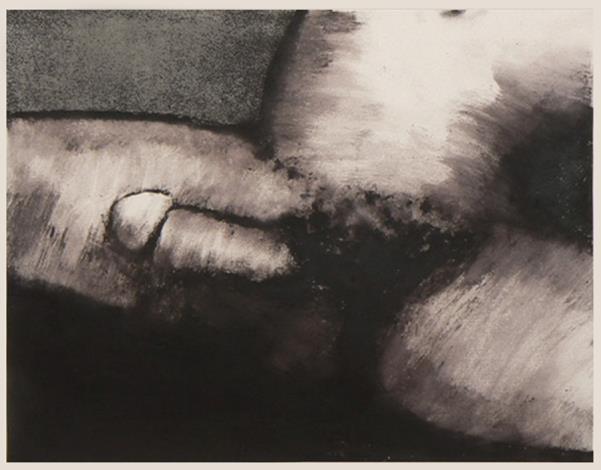
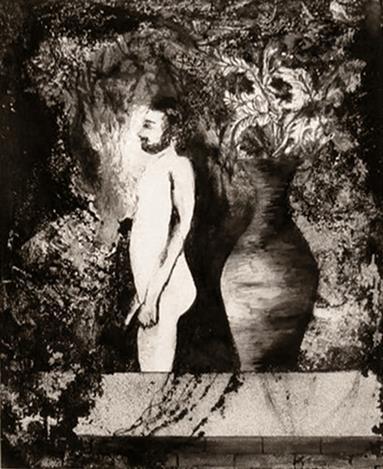
118
Ellen Kieffer. For Display Only. 2010. Water based printing inks, 100 rag paper. 20 x 16 inches.
Ellen Kieffer. Subjective Perspective. 2010. Water based printing inks, 100 rag paper. 16 x 20 inches. *
"Where's His Head?" This drawing was inspired by my mentor and surrogate father, the brilliant anthropology professor, Allan Coult, in Berkeley, 1969. He used to sit at the old Café Mediterraneum on Telegraph Avenue watching passersby, and occasionally I would join him. One day, as we sat sipping coffee and taking in the view, he happened to comment that most men were "walking around with their heads in their dicks and their dicks in their heads." I immediately got this image that I just had to put down on paper. Previously Coult had talked about the phenomenon of "narcissistic trance," a subconscious construct based on buried fear and self-loathing. I integrated these ideas in the drawing. At 21, I had enough experience to depict the male anatomy from memory, and an instinctive understanding of the relevant sociological and psychological concepts.
After Coult's death the following year, and through the decades, relishing without regret many loving relationships embodying primal passion, heartbreak, and undying friendship, I saw the familiar pattern of narcissistic expression reappear all too many times. I even got a clinical definition of narcissism via an old boyfriend after his therapist diagnosed him with a bad case of it. He was a charming, clever rake who resorted to therapy only after breaking dozens of women's hearts, including mine, and being sued for divorce by one of them the others knew nothing about. I remained a platonic friend and let him tell me all about it. Apparently, when you suppress your real self or fear that no one would love it in favor of an ego fabrication constructed to impress, you're sending a shadow of yourself out into the world. No one else really exists in that world, because you yourself hardly do. It's bound to create problems.
I believe that narcissism has grown out of proportion in our society, causing many ills. Perhaps because I'm a heterosexual woman, I see this problem mainly in men. While I have great empathy for the wounded male psyche, I yearn for a healthy man with his head and his dick in the right place, one who is in touch with his fears and is able and willing to overcome them. I know this is possible because my teacher was one such man. Besides being to this day the smartest, funniest, and most fearless man I've ever known, he also taught me a trade by showing me how to start a newspaper from scratch; taught me how to stop being a lazy young punk and get to work; that we are not our egos; that we're all cut from the same cloth; that God is within; and many other basic life lessons that have given me the ground upon which I'm rooted.
I hope this vintage drawing provides deeper meaning to the term "dickhead." Meanwhile, I continue to dream of finding a man who's just the opposite my #1 Head Dick. Karen Klaber

119
Karen Lance Klaber. Where's His Head? 1969. Print on paper. (original burned in fire). 18 x 9 inches. *


120
Corlia Kock. Object Of My Desire 12. 2011. Mixed media on canvas. 30 x 40 inches.
Susan Kraft. Reclinging Nude Male. 2011. Acrylic on stretched canvas. 20 x 30 inches. *
Diana Krevsky. Beware of the Troll Man. 1993. Acrylic on canvas and faux flowers. 52


121
x 24 x 18 inches.
Beth Lakamp. Rainbow Man. 2010. Oil on canvas. 15 x 54 inches.

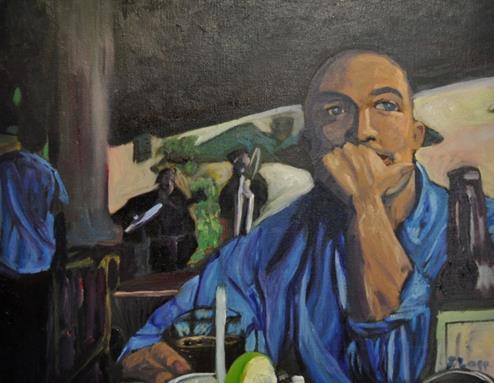
122
Lark. Magician. 2009. Sand paper, plastic, cut paper bag, poster, ink, acrylic on board. 29 x 23 x 1.5 inches.
Sarah Lapp. Plotting Man. 2010. Oil on canvas. 11 x 14 inches.

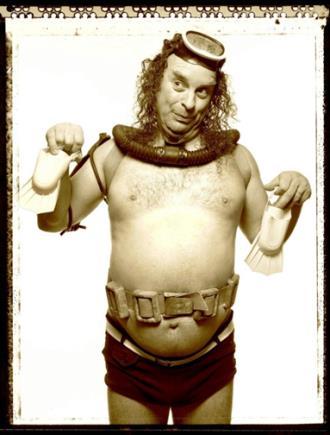

123
Allison Leach. (left to right) Sexy Beast. Jacques Cluelez. Shy Savage. 2008. Archival print. 20 x 16 inches each. *


124
Evie Leder. Object Number One. 2009. Video. 13 minute loop. *
Lee Lee. Leap. 2007. Oil on panel. 48 x 32 inches. *
The public profile of a man is for statisticians and future employers. I prefer men raw, i.e., stripped of educational background, religious affiliation, material possessions, and societal connections. There is a certain vulnerability in a man thus laid bare that I find quite attractive, even more so if the man in question does not know that I am watching him. It therefore follows that my portrayal of men in their natural state is that of the artist as voyeur. Sharon
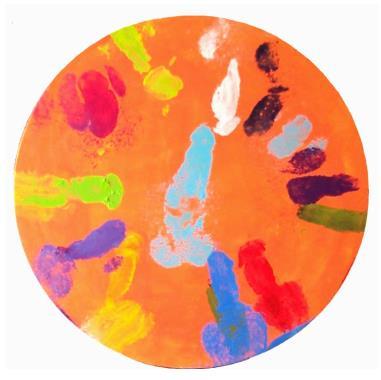
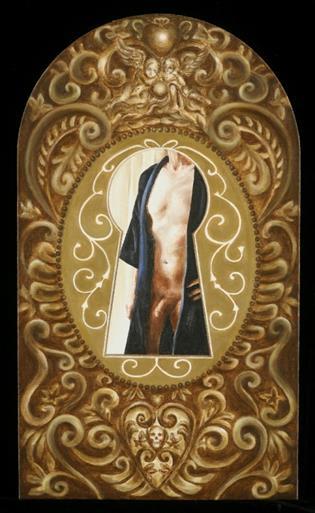

125
Leong
Sharon Leong. Handgela. 2002. Acrylic paint on canvas. 12 x 1 inches.
Sharon Leong. Cockpit. 2001. Acrylic paint on stretched round canvas. 20 x 1 inches.
Sharon Leong. Victorian Keyhole. 2011. Acrylic on canvas. 19 x 11 x 1 inches. *
Man is the subject of the ads. To sell products he shows his muscles and penis. This would be embarrassing and degrading to most men as the reverse gaze is to women. We do not want to be seen as an object in advertising, distorted in fine art, degraded in literature, or second class in our culture. Lynn Elliott Letterman

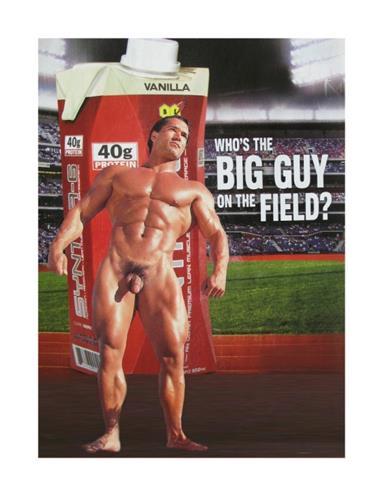
126
(left) Lynn Elliott Letterman. Construction Guy. 2010. Photomontage. 12.5 x 9 inches.
(right) Lynn Elliott Letterman. Big Guy. 2010. Photomontage. 20 x 17 inches. *



127
Amelia Lewis. Tribesman (Native). 2010. Acrylic on canvas. 60 x 36 inches. *
Lory Lockwood. Stairway to Heaven. 2010. Mixed media. 20 x 20 x 1 inches. *
Kelsey Livingston. Richard. 2011. Oil on canvas. 28 x 34 x 1 inches.
The intention of my work is to challenge mainstream perceptions and attitudes towards traditional notions of beauty. People in general become uncomfortable when they are around something that they are not familiar with. This can be any number of things from people of different ethnicities to normally unseen body parts. In my work, the goal is to bring into public view that which most people are uncomfortable with in order to challenge and provoke the viewer.


 Michelle Lopez
Michelle Lopez
128
Michelle L. Lopez. Male Nude #1. 2010. Silver gelatin print. 20 x 16 inches. *
Michelle L. Lopez. Male Nude #2. 2010. Silver gelatin print. 20 x 16 inches.
Michelle L. Lopez. Penis #1. 2010. Silver gelatin print. 8 x10 inches.


129
Jacalyn Lopez Garcia. Build A Boy Toy. 2011. 3 wooden frames and color digital prints with QR codes. 18 x 66 x 1.5 inches.
Jacalyn Lopez Garcia. Themanhuntproject.com. 2011. Multimedia installation on a computer with photographs, QR codes and audio. 2:45 minutes. *



130
So Yoon Lym. (left to right) Angel. Hector. William. 2010. Acrylic on Paper. 30 x 22 inches. *
Cat Lynch. The Perfect Gentleman, from the Pulp Series. 2010.
Photography. 20 x 26 inches. *

Cat Lynch. The Lone Wolf. 2010.
Photography. 20 x 26 inches.

131


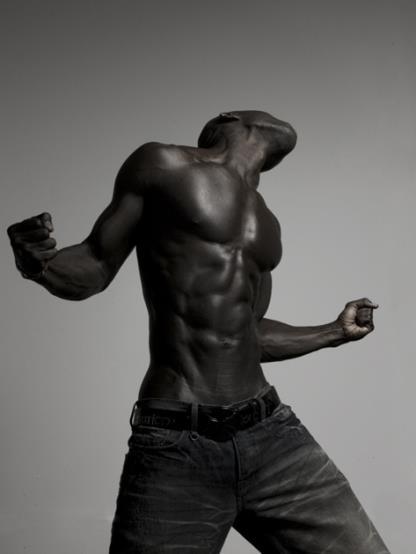
132
Sita Mae. After the Rain. 2011. Photography on aluminum. 6 x 4 inches.
Sita Mae. Modesty. 2007. Photography on aluminum. 6 x 4 inches.
Sita Mae. The Triumph. 2008. Photography on aluminum. 14 x 11 inches. *
Kelsi Mannhalter. (clockwise) Smooth. Adore. Pleazboy. 2011.


Photography, digital altering, digital collage. 30 x 20 inches.
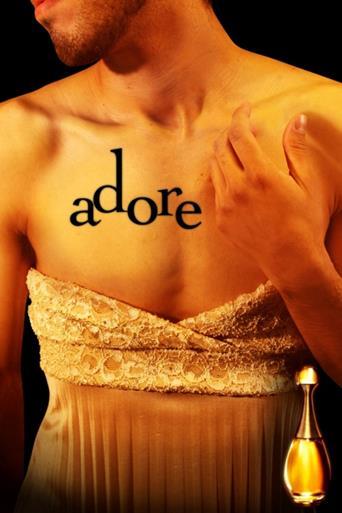
133
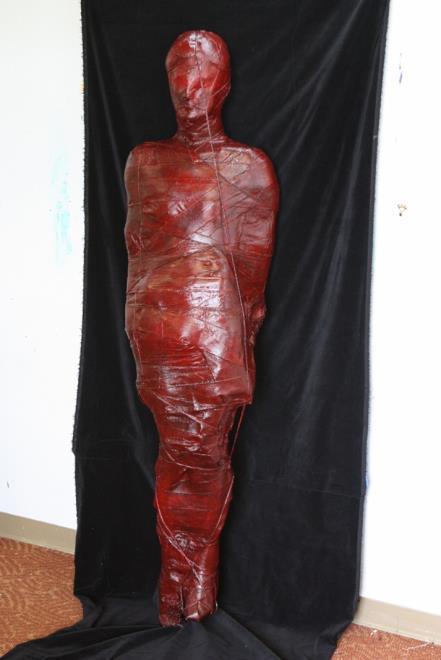

134
Louise Maloof. Man Objectified. 2011. Mixed media. 78 x 22 inches.
China Marks. In the Pink. 2005. Fabric, thread, silk-screen ink, pom-poms, fusible adhesive. 30 x 26 inches.
Much of the history of western painting is indebted to dead white men who painted from their libidos and fashioned their own private archetypal sexual ideal—Rubens and his buxom blondes, Bouguereau's milky-skinned brunettes, even Caravaggio's brooding pretty boys. Absent from the fray is the female counterpart which, impermissible in previous eras, remains uncharted today. My series is a calculated effort in owning the image of my physically ideal man via feminizing poses.

 Kristina Martino
Kristina Martino
135
Kristina Martino. Alain Delon #1. 2011. Black pencil on paper. 18 x 30 inches. *
Karen Mathews. Lips. 2008. Digital image. 11 x 16 inches. *


136
Jeanette May. Easy on the Eyes: Dorothy. 2010. Archival pigment print on Hahnemuhle photo rag paper. 20 x 40 inches.
Jeanette May. Easy on the Eyes: Harriet. 2009. Archival pigment print on Hahnemuhle photo rag paper. 20 x 40 inches.


137
Kristine Mays. The Need. 2010. Wire. 27 x 22.5 x 10 inches. *
Jeanette May. Easy on the Eyes: Lelia. 2010. Archival pigment print on Hahnemuhle photo rag paper. 20 x 40 inches. *
I am a sex-positive feminist photographer. I do not have a male gaze and I am not concerned about the “size of my lens.” My gaze does not consume and dominate; it is not threatening in the way that a traditional male gaze can be. My gaze is wide and it sees people who are usually unseen. It is important to me that my subjects help to create their own representation. I want them to retain that power. I'm not here to objectify or harm; I'm here to nurture and document.



138
Shilo McCabe. Damani. 2011. Digital photograph. 24 x 20 inches.
Shilo McCabe. Jim. 2011. Digital photograph. 20 x 24 inches. *
Shilo McCabe. Ned. 2011. Digital photograph. 20 x 24 inches.
Shilo McCabe
The lithe young male preens and poses before a mirror for us. His is a fatal attraction the Narcissus.


139
Alysanne McGaffey. Narcissus. 2008. Pencil Drawing on Paper. 20 1/2 x 16 inches.
Alysanne McGaffey
Harrigan McMahon Bowman. In the Passenger's Seat. 2010. Digital C-Print. 16 x 21 inches.


140
Erika Meriaux. Heracles and Omphale. 2010. Oil on linen canvas. 48 x 48 inches. *
Carol Morris. JustBoys.com. 2011. Paper, laminated by artist. 5.5 x 8.5 x 1.5 inches. *
I picked up a free periodical in San Francisco's Castro District. Thirty lurid pages of half-clad teen aged boys in provocative poses. The publisher intended to appeal to gay men for the purpose of selling sexual services. As I doodled and altered the images, I realized it was through the looking glass of the desires and fantasies of a heterosexual woman. I objectified and feminized these boys, mocking their male sexuality by using pink colors, hearts, flowers, glitter, whimsy and humor. Carol Morris


141
Carol Morris. JustBoys.com. 2011. Paper, laminated by artist. 5.5 x 8.5 x 1.5 inches.
Carol Morris. JustBoys.com. 2011. Paper, laminated by artist. 5.5 x 8.5 x 1.5 inches.


142
Amy-Elyse Neer. The Affair. 2009. Male figure of TV test patterns in oil and collage. 44 x 44 inches.
Jill Nonnemacher. Nude Male On Blue Chair. 2011. Acrylic on canvas. 24 x 18 x 1.5 inches.


143
Barbara Neri. Who are these Men?. 1994. Paper, mylar, color pencil and marker, plexiglass. 20 x 30 inches.
Janice Nesser. climbing out of the white. 2008. Inkjet print, plexiglass. 6 x 4.5 Feet. *
Nancy Netherland. Bath. 2011. Mat printed photo. 11 x 17 inches.

Nancy Netherland. Prayer. 2011. Mat printed photo. 11 x 17 inches.

144
My work uses portraiture to explore the embodiment of queer identities. Viewers are invited to gaze upon the subject, a gaze not easily categorized into a binary system of reversible opposites, but one complicated and enriched by modern understandings of the intersections and complexities of gender, body, and desire, rather than false heteronormative assumptions. Queer gazes are inherent in my work, beginning with my own upon the model, as I scrutinize and objectify the form to create the painting. Molly


145
Molly Marie Nuzzo. superman. 2011. Oil on wood. 38 x 24 inches. *
Molly Marie Nuzzo. Noah. 2011. Oil on wood. 33 x 48 inches. *
Marie Nuzzo
My work consists of a series of wall installations featuring Antique dishes that have been altered with the use of photo-transfers to create humorous commentary on the subject of Male Pride. Using images of men with their fishing trophies appropriated from social networking sites, I play with the perceptions of men and their images of themselves. Without the use of nudity or overt sexuality, I turn the traditional male gaze back on man himself and away from the tradition of woman as object. With tongue and cheek humor I invite the viewer to consider man as object, man as the main course. Can we judge a man by the size of his catch? I will leave that for the viewer to decide. Brenda Oelbaum

Brenda Oelbaum. Does this make my dick look big? Carpe Carp #2. 2011. Antique china with photo-transfers. 30 x 20 inches. *
Beth Olds. Dekka Raymaker. 2011. Video. 33 seconds. *

146
The insane free-agent market and the expectation that athletes play at superhuman levels helped usher in the steroid era. Wearing tight uniforms that showed off their enhanced musculature, ballplayers basked in the adoration of their fans, owners, and most of all, themselves. Adoration consists of Jose Canseco's signed bat and two American League baseballs. His enormous bat symbolizes his enhanced talents; the dwarfed balls, the predicament he found himself. Priscilla Otani


147
Colleen O'Donnell. Desire. 2011. Bronze. 6 X 10 X 5 inches. *
Priscilla Otani. Adoration in the Steroid Era. 2010. Baseball bat, two baseballs. 6.5 x 36.5 inches. *

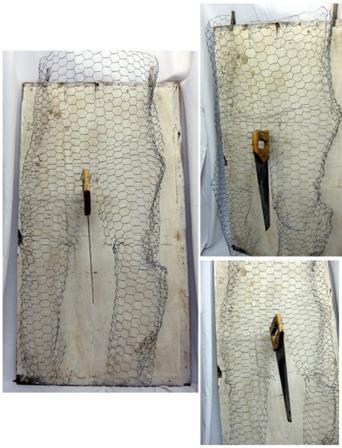
148
Jacki Orr. The Cowboy Way. 2010. Acrylic on paper. 34 x 40 inches.
Jacki Orr. Veni Vidi Vici. 2009. Assembled found objects: wire, hand saw, wood, clothespins. 47 x 25 x 13 inches.
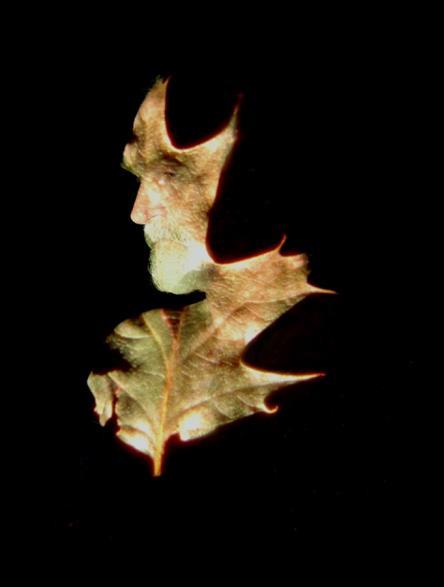

149
Arla Patch. Green Man. 2010. Photo on archival paper. 30 x 25 inches.
Nancy Peach. Male Bondage. 2011. Oil on canvas with gold leaf. 72 x 48 inches.


150
Rachael Perisho. Untitled (Gaze no. II). 2011. Acrylic on panel. 42 x 31 inches.
Heather Pilapil. Errol. 2004. Oil on linen. 20 x 16 x 2 inches. *
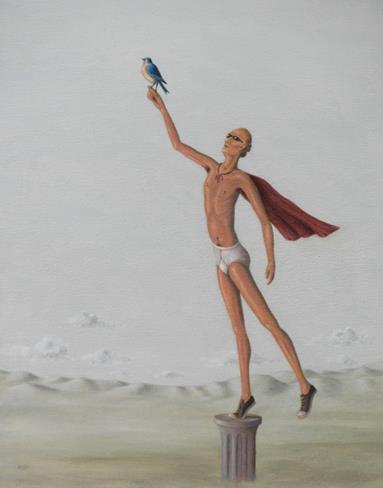

151
(left) Karen Purdy. Cowboy in a Box. 2006. Oil on panel. 8 x 10 inches. *
(right) Karen Purdy. Captain Underpants. 2009. Oil on panel. 10 x 8 inches.
The animation of the male in traditional ways often reserved for women, that of extravagant and fanciful yearning, tenderness and romantic doom, often requires the coercion of sexual ambiguity and a vexatious tearing away of expectations. In my photographs, involving soldiers as the archetype of what are considered male characteristics, of moral and emotional immobility, are here yielding and pliant. They challenge the notion of male and masculine. They are beautiful and splendiferous in their suffering and desires. Xian Mei QIu

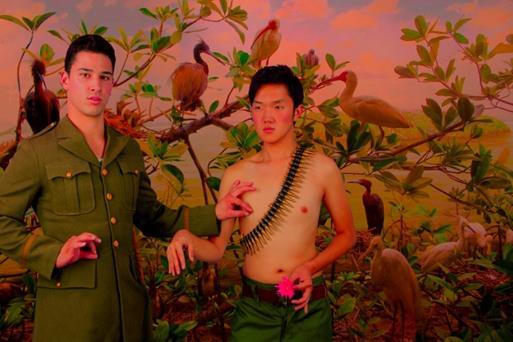
152
(left) Xian Mei Qiu. In the Manner of Gabrielle d'Estrees. 2011. Mixed media photograph on plexi-glass. 30 x 40 inches.
(right) Xian Mei Qiu. Let a Thousand Flowers Bloom 8875. 2010. Photograph on paper. 30 x 40 inches.
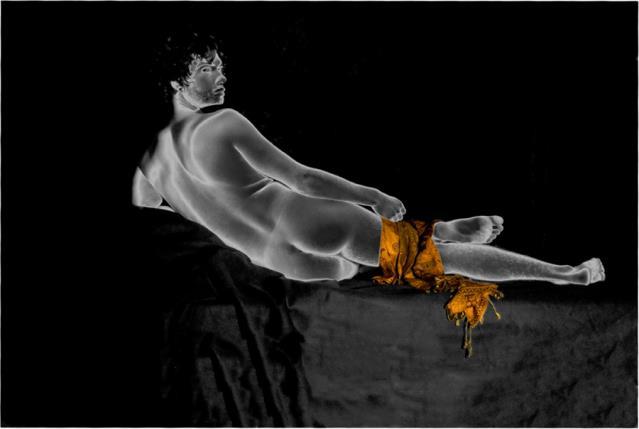

153
Patricia Quilichini. Untitled 2. 2011. Photography. 13 x 19 inches.
Xian Mei Qiu. Ophelia. 2011.
Photograph on plexi-glass. 44 x 66 inches. *
Nora Raggio. Andres Before His PhD Dissertation
Soaking in the Bathub.

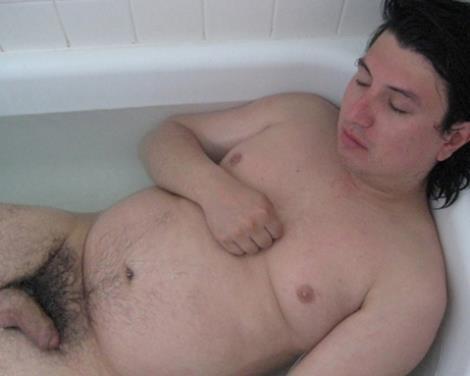
Nora Raggio. Andres Vulnerable to the Camera.
(All) 2011. Digital photography printed with archival ink on archival paper. 16 x 20 inches. *

154
Nora Raggio. Andres Asleep Before Dissertation.


155
(left) Cherie M Redlinger. BOYS WILL BE BOYS. 2010. Multi-techniques of printmaking. 24 x 18 inches.
(right) Cherie M Redlinger. STRAIGHT JACKET. 2010. Multi-techniques of printmaking. 24 x 18 inches.
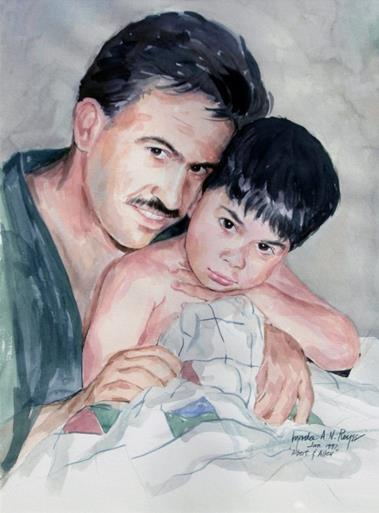

156
(left) Lynda A. N. Reyes. Morning News. 2009. Transparent watercolor on paper. 22 x 30 inches.
(right) Lynda A. N. Reyes. Father and Son. 1997. Transparent watercolor on paper. 22 x 18 inches. *
These images are part of an ongoing series of portraits that document my collaboration with Frederic Koenig, who can so naturally appear both handsome and feminine. Wearing nothing more than spike heels, he provocatively poses in a gritty, industrial environment that reinforces a traditional male landscape. While his upper body exudes a masculine power, his raw and curvaceous physicality and his archetypal pin-up girl shoes challenge the viewer to explore how we perceive masculinity, sexuality and gender identity. Trix Rosen
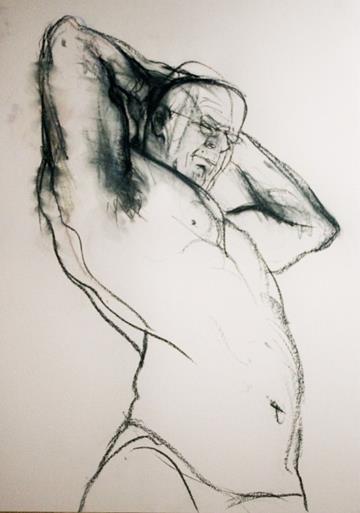
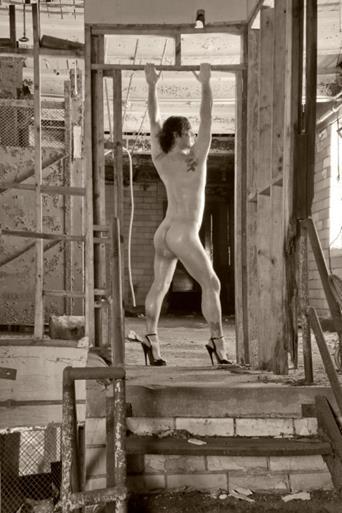
157
Trix Rosen. Beyond XY: Inside the Abandoned Falstaff Brewery. No.2. 2010. Archival pigment print. 30 x 20 inches.
Judith Roth. Chris. 2007. Charcoal on paper. 32 x 24 inches. *


158
Laura Rusnak. CWO #1: Bare Heart Blinded and Bloodied. 2011. Metallic photographic print. 24 x 36 inches.
Carla Sanders. 9 Cocks. 2010. Graphite on charcoal paper. 36 x 27 inches.


159
Loredana Sangiuliano. (l to r) Bodybuilder 1. Bodybuilder 2. 2010. Giclee paper. 10 x 8 x 1 inches.
It is surprising and inexplicable to me that through the years, although the women's fig leaf was removed from her nude figure, it was not considered appropriate or moral to show the male genitals. It also appears strange to me that male genitals can be displayed on statues but are considered shocking in paintings. Could it be because most accepted artists are and have been male? Clara Saprasa
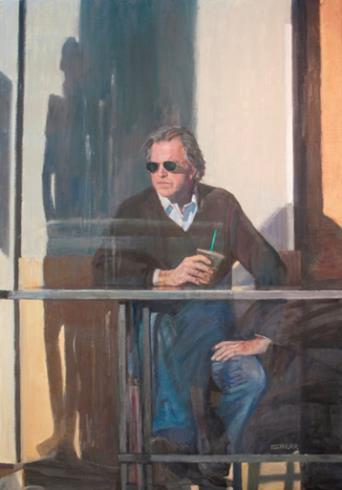

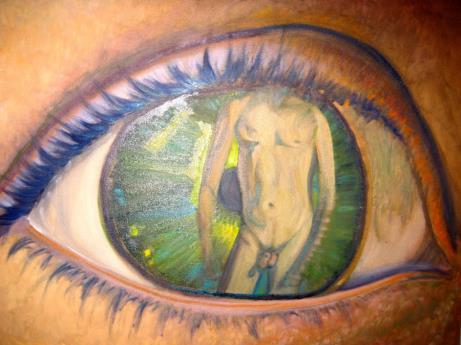
160
Clara Saprasa. Object. 2011. Oil on canvas. 16 x 20 inches. *
Elinore Schnurr. Still Life. 2008. Oil on linen. 32 x 28 inches.
Elinore Schnurr. Waiting. 2010. Oil on linen. 50 x 35 inches.
Often in images women are presented as mysterious, ethereal, unknowable beings, whereas men are often shown in a straightforward, serious, understandable manner. This has always felt very incorrect to me, as I feel that everyone holds onto their own unspeakable mysteries. To prove my point I took visual cues from traditionally feminine images applied them to a male subject. I wanted to see how this type of feminine imagery would read when presented with a male subject, particularly one with a full beard and chest hair.


161
(left) Centa Schumacher. Retiring. 2011. Photograph. 18 x 12 inches.
(right) Centa Schumacher. Rising. 2011. Photograph. 18 x 12 inches.
Centa Schumacher
Judith Segall. You've seen one, you've seen 'em all. 1994. Surgical gauze impregnated with plaster. 15 x 30 x 3 inches. *

Judith Segall. Penises & Tallises (Thou Shalt Put No Gods Before Me). 1996. Surgical gauze and handmade paper. 15 x 30 x 3 inches.

162
Shizue Seigel. Scrutable. 2011. Acrylic on canvas. 30 x 40 inches. *
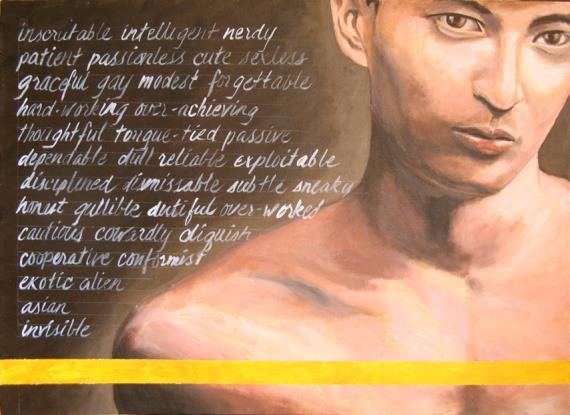


163
Sal Sidner. Drummer. 2010. Oil on canvas. 24 x 18 inches.
Sal Sidner. Young Buddha. 2009. Oil on canvas. 40 x 30 inches. *
Sarah Sipling. Look at me 1. 2010. Aquatint and drypoint. 6 x 11 inches.


164
Bonnie J. Smith. DAD. 2008. Cotton & rayon fabrics, polyester batting and rayon threads.. 54 x 90 inches. *
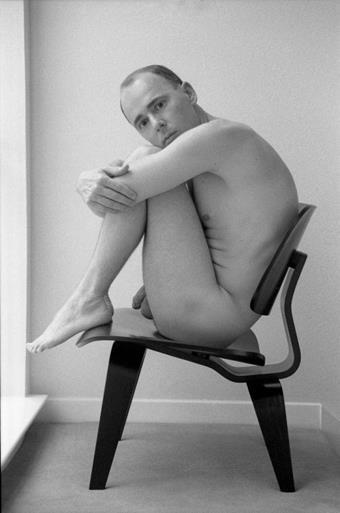

165
Priscilla Smith. Man in Eames. 2010. Archival pigment print. 18 x 12 inches. *
Madelyn Smoak. David and His Junk. 2011. Found objects, copper, sterling silver, archival images, resin, handmade chain. 22 inches. *
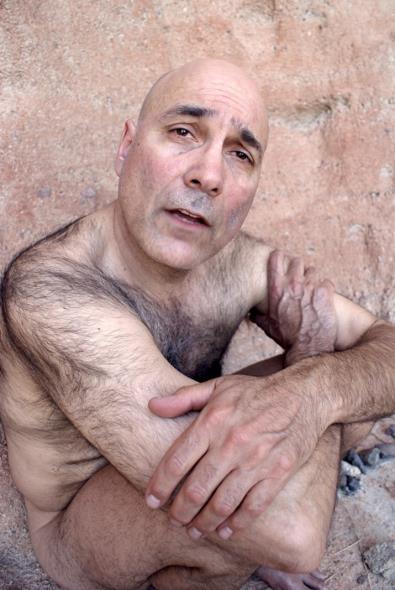

166
Jenny Snyder. Man II. 2011. Paper. 48 x 24 inches.
Julie Snyder. Seeking the Target. 2007. Oil on canvas. 36 x 18 inches.
Elizabeth Sowell-Zak. Nude to Personality: Angel Seated. 2010. Oil on canvas. 16 x 12 inches.


Susan Spaniol. Close Encounter. 2010. Ink on wet RFK Rives printing paper, previously stained with coffee. 30 x 20 inches.
Elizabeth Sowell-Zak. Nude to Personality: Angel In Repose. 2011. Oil on canvas. 12 x 16 inches.

167
*
These images evoke a soft and sensual view of men which is not often shown. At first response each man responded in a sexual way: as if in a voyeuristic erotic game. As time went on their response changed to one of intimacy and trust, gradually becoming more and more exposed. It’s at that moment when, open and vulnerable, that the men become not only intensely erotic, but a figure of beauty captured for all to see.


 Colette
Colette
Standish
168
Colette Standish. Curves. 2010. Liquid light on paper. 10 x 8 inches.
Colette Standish. Intimate. 2010. Liquid light on paper. 8 x 10 inches.
Colette Standish. Reclining Male. 2010. Lith print. 10 x 8 inches.
When men have been pictured as subject or spectacle, it has been in service of their power. Portraits of them throughout time have shown us men as power brokers, leaders, and patriots. While women have been painted as the object, subordinated, and sexualized, the historical male portrait represents a normative and ideal view. In the Union series, reversing the gaze means taking an expected image of American power and confusing it. Julie Sutherland
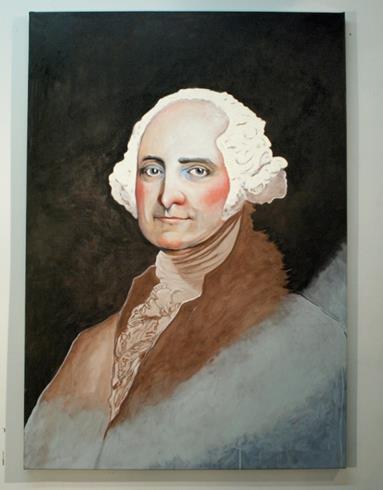

169
(left) Julie Sutherland. Dolleyjames Madison. 2010. Oil and acrylic on canvas. 48 x 53 inches.
(right) Julie Sutherland. Marthageorge Washington. 2010. Oil, acrylic and conte on canvas. 55 x 59 inches.
Challenging the Gaze
“Do women have to be naked to get into the Met. Museum?” asked the Guerilla Girls, an anonymous collective of feminist art activists, on posters they created in 1989. Below their unflinching question they reveal, “Less than 5% of artists in the Modern Art Sections are women, but 85% of the nudes are female.” Such work poignantly exposes the continued power in numbers held by exhibiting male artists within the art world and the pervasiveness of their gaze. Acting as one locus of repression in the art world and society at large, the gaze has a long history both of male use and of female attempts to scrutinize, manipulate, and reverse it.
Today, many women still follow in the revolutionary steps of artists like Carolee Schneemann, employing their own nude bodies or those of other women to make artwork that questions those individual bodies’ connection to the social body. They ask, as Schneemann did in her 1968 performance of Naked Action Lecture, “Does a woman have intellectual authority? Can she have public authority while naked and speaking?” and “What multiple levels of uneasiness, pleasure, curiosity, erotic fascination, acceptance or rejection were activated in an audience?” They are raising doubts that the nude female can only be depicted as a sexual object, and propose instead that alternative meanings must exist after so many years and so many naked pictures.
Certainly these attempts at reworking and analyzing the gaze are important because as feminist film theorist Laura Mulvey points out, “It gets us nearer to the roots of our oppression, it brings an articulation of the problem closer, it face us with the ultimate challenge: how to fight the unconscious structured like a language (formed critically at the moment of arrival of language) while still caught within the language of the patriarchy.”1 The position of this exhibition, reversing the gaze, is another possibility for fighting something so ingrained. With men placed in the position of spectacle, male audiences will now encounter their own likenesses mirrored back at them and are then faced with all the implications of
that viewing. Will they experience themselves as passive sex objects or as something different altogether? What will they make of their masculinity? What connections will be made to the oppression engendered by their male gaze? Given the socialization of men, can they even experience a true reversal?
Speaking only for myself and of my own artistic practice, I propose that one good starting point for effective reversal might be found in work that employs Bakhtin’s carnivalesque laughter because of its revolutionary and communal spirit. It has been described as an “ancient communal laughter” and a “potent form of social revolt, kept alive primarily by small groups of women.”2 However, I recognize with the intention of using laughter that, “The viewer must want, at least briefly, to emancipate himself from ‘normal’ representation; in order to laugh, he must recognize that he shares the same repressions.”3 I remain hopeful for this flash of recognition, and laughing. by
Erika Swinson

1 Mulvey, L. (1999). Visual Pleasure and Narrative Cinema. In Leo Braudy and Marshall Cohen (Eds.), Film Theory and Criticism: Introductory Readings (p. 834). New York: Oxford UP.
2 Isaak, J. A. (1996, p. 17). Feminism and contemporary art: The revolutionary power of women's laughter. London: Routledge.
3 Isaak, J. A. (1996, p. 5). Feminism and contemporary art: The revolutionary power of women's laughter. London: Routledge.
170
Erika Swinson. Playing Peter. 2007. Video. 11:37 . *
My dolls are inspired by Raphael's The Three Graces, personifying the best qualities in women. Today, what women find desirable in men is skewed by our celebrity driven and money worshipping culture. Beauty is shown as a movie actor and baseball player. Charm, an attribute used to gain influence, is a politician and a doctor. Grace, associated with creative joy, is a rockstar. As more dating is pursued on the internet, all will be subjected to the instant judgmental “gaze” of computer approval based on looks and assets.
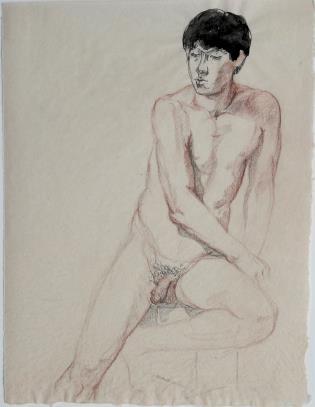


171
Yuriko Takata. The Three Graces Paperboy Dolls. 2011. Paper and wax crayon. 72 x 85 inches. *
Lani Tanaka. Sleeping During the Day. 2011. Oil on panel. 16 x 24 x 1.7/8 inches.
Yuriko Takata
Patricia Terrell-O'Neal. Oneal3. 2005. Ink on Japanese paper. 11.5 x 9.5 inches. *
The concept of "Reversing the Gaze" is of great interest to me as someone who was painfully shy as a child and young adult; the obvious attention of men as I became a young woman was quite uncomfortable. I don't know whether it felt like a threat or if it just made me painfully aware of what I perceived as my shortcomings. When you grow up with the media's representation of the ideal female form, a real woman can never quite measure up.
As a young, blonde female in the Texas Panhandle, catcalls, honks and comments as I rode my bike on hot days drove me to wear long sleeves, no makeup and work boots. Yet I still had a couple of scary, close calls; with an intruder in my bed and a nude man in a car. I never learned to accept this attention as any kind of compliment, to me it felt impersonal and even threatening, more like an exercise of masculine power. Even a few years later, when a roommate who was an ex-boyfriend tried to rape me, I did not report it to the police as I had previously not reported the intruder. I feared the police were just as threatening, and would try to reverse the blame, and say perhaps I was dressing provocatively or an idiot for staying in the same house even though he had never exhibited any irrational or violent behavior before.
It has taken getting older and becoming a "woman of a certain age" for me to at last appreciate a compliment or a second look. If I'd felt more empowered and less vulnerable as a young woman could I have enjoyed the attention I received?
"Reversing the Gaze" allows us to think about the possible objectification of men, something society generally relegates to gay men and the sadly named "cougars." Doesn't that seem to signify that if a woman honestly and openly appreciates the male form it means he’s in danger of being devoured. My generation was taught to be demure and not make the first move, I wonder at missed opportunities in the past.
One of the few icons of masculine beauty in the history of art is Michelangelo’s David. And why is it that the male "member" is much more shocking than the female form. Women surely have much more of an aesthetic bent than most men. Must we be reduced to the stereotype of desperate older women or streetwalkers if we admire a man's body? How would men react if we started treating them like meat, the way women have been?

As we evolve as a society in this post-sexual resolution era, can we truly behave as equals? Can women dress in six-inch high heels and short skirts (like Barbie dolls) and act like Ken? Or is there a day ahead where we drop the narrow definitions of gender and gender behavior and treat each other like human beings, with honest and open responses to each other? And, instead of sexual aggression and power games, behave with pure intent and honest desires? Wouldn't it be nice if men didn't have to do all the work and could feel objectified occasionally?
Deborah Mills Thackrey
172
Deborah Mills Thackrey. Male Plumage. 2004. Archival pigment print. 24 x 20 inches.
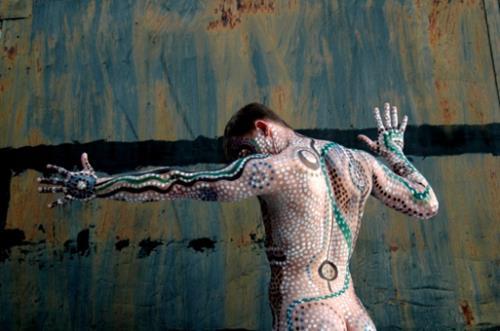

173
(left) RoByn Thompson. Hermes. 2007. Photograph on metallic print. 24 x 36 inches.
(right) RoByn Thompson. Wain. 2009. Photo print on metallic paper. 24 x 36 inches.


174
(left) Lynne Todaro. Stud. 2010. Graphite on wood. 4 x 4 x 2 inches. *
(right) Lynne Todaro. Stud 3. 2011. Graphite on wood. 9 x 4 x 2 inches. *
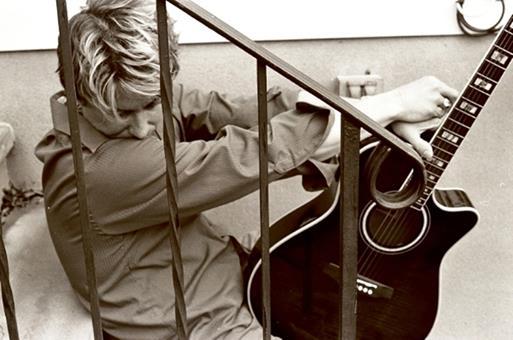

175
Linnea Tober. Portrait with Guitar 3. 2010. Photography, paper. 11 x 17 inches.
J. Toffic. The Collector. 2010. Wooden typeset printer tray, clay, pins, ink, paper, glue. 17 x 33 inches. *
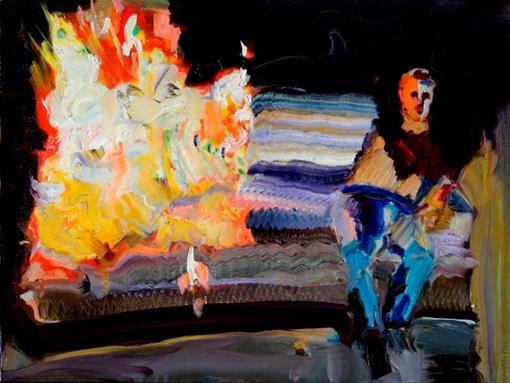
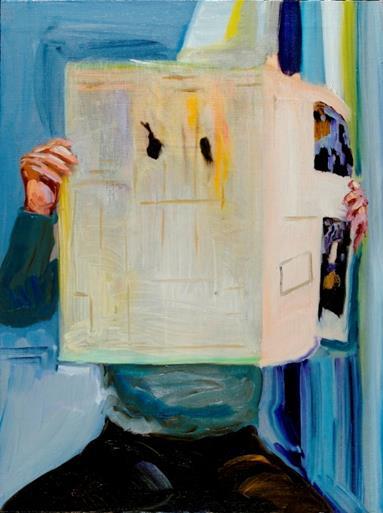
176
(left) Mette Tommerup. Burning Sofa. 2010. Oil on linen. 12 x 16 inches.
(right) Mette Tommerup. Newspaper. 2010. Oil on linen. 16 x 12 inches.
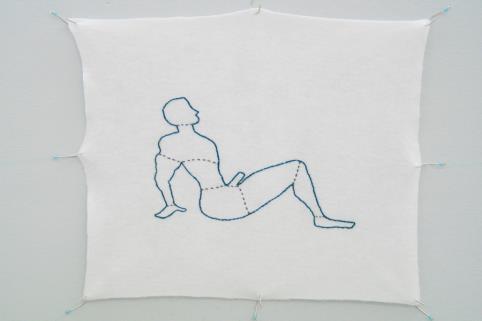


177
Cristina Velazquez. Man Chops. 2011. Mixed media. 36 x 36 inches. *
Christina Renfer Vogel. Portrait of Two Brothers. 2008. Oil on canvas. 36 x 48 inches. *
Susan von Gries. Nude I. 2009. Printer's ink, Somerset rag paper. 17.5 x 12 inches. *


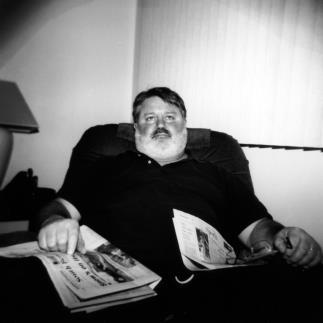
178
Alexandra Walker. (left to right) Resting. Jacob. Driver. 2011. Gelatin silver. 9.5 x 9.5 inches.
Much as I dislike the dictum “biology is destiny,” I have to admit its relevance to the subject of power. For men, it is overwhelmingly “power over;” for women, overwhelmingly “power with.” And there are excellent biological reasons for that fundamental difference. The higher men rise in the power structure, the more sexual advantages they are (or feel they are) entitled to. Who said “power is the ultimate aphrodisiac?” They weren’t referring to women.
Women, on the other hand, desperately need the help and support of other women during child-bearing years, and the habit endures. Faced with a challenge (or disaster), women reach out and form alliances and collaborations with ease.
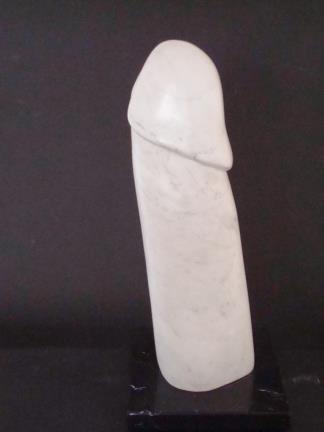

So there you have it: Power Over or Power With. I know which side I’m on. Ruth Waters
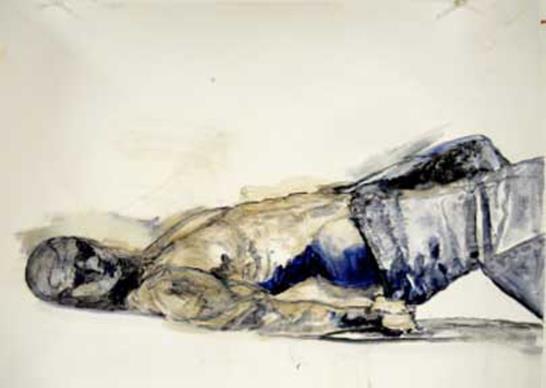
179
Theresa Walloga. Jeans Ad. 2010. Oil on paper. 18 x 28 inches. *
Ruth Waters. Adonis. 1998. Locust wood. 29 x 9 x 9 inches. *
Ruth Waters. Penis. 1995. Marble. 15 x 3.5 x 3.5 inches. *


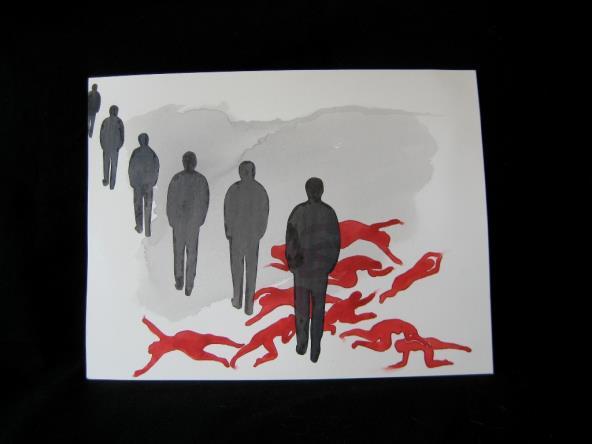
180
Jennifer Weigel. Manhood. 2009. Fabric marker on cotton men's briefs underwear, children's toys, cotton thread. variable. *
Susan Weisberg. Gone, Again. 2011. Watercolor and tracing paper on Fabriano Artistico paper. 12.5 x 16.5 inches.
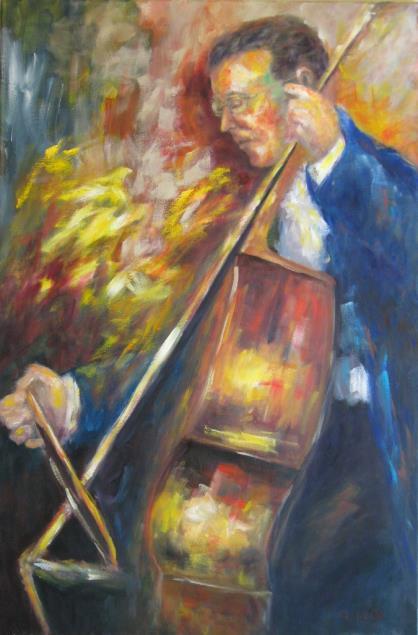


181
Rachel Weissberger. Bass Magic. 2011. Oil on canvas. 36 x 24 inches.
Rachel Weissberger. Street Samba. 2010. Oil on canvas. 36 x 24 inches.
Rachel Weissberger. Trombone Player. 2011. Oil on canvas. 24 x 24 inches.


182
(left) Carolyn Weltman. Gods and Men. 2008. Oil on canvas. 21 x 26 x 2 inches.
(right) Carolyn Weltman. The Very Strong Man. 2003. Pencil, watercolor and gesso on 100% cotton rag. 13 x 19 inches.



183
Ellen West. The Handy Man's Special. 2011. Lead letters, ceramic plate, mirrors, nails, screws, S hooks, 'tools'. 15 x 15 x 3 inches.
Corinne Whitaker. Ornamental Man. 2010. Plexi and gold foil. 24 x 24 inches. *
Tamara White. The Brain. 2010. Acrylic and paper on canvas. 8 x 8 inches. *


184
(left) Melissa Wilkinson. Boy with Feathers. 2011. Watercolor on paper. 20 x 16 inches.
(right) Melissa Wilkinson. Boy on Counter. 2011. Watercolor on paper. 20 x 16 inches.


185
(left) Sheila Winner. Unbuttoned. 2011. Pastel on pastel paper. 10 x 13 inches. *
(right) Sheila Winner. 9:00 AM. 2011. Pastel on pastel paper. 21.5 x 18.5 inches.



186
Kathryn Wood. Eye Candy. 2010. Photo paper. 20 x 16 inches.
Kathryn Wood. Objects. 2010. Photopaper. 20 x 16 inches.
Carol Witten. Fresh Direct. 2011. Rag photographic. 24 x 30 inches.


187
Jan Wurm. Golfers. 2009. Oil on canvas. 60 x 144 inches.
Jan Wurm. Reverie. 2009. Oil on canvas. 72 x 48 inches.

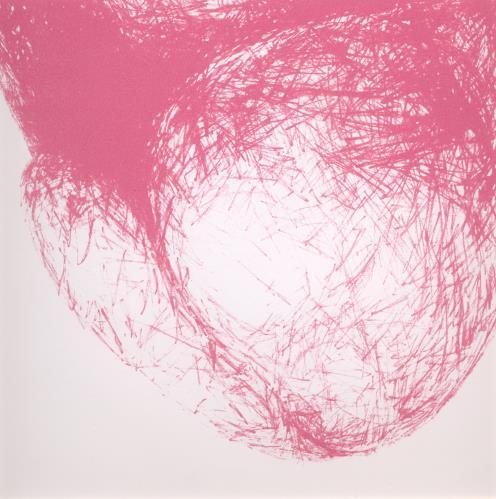
188
Jenny Wrenn. The Traffic Stop. 2007. Oil on canvas. 42 x 34 inches.
Nanette Wylde. Pinkie. 1992. Lithograph on Rives BFK. 8 x 8 inches. *
Masculine/feminine turnabouts have had a place in the history of the arts for a long time. In the past it was totally taboo for women to gaze upon the male, yet it was appropriate and common in the reverse. Do you think that things are changing? Marian Yap
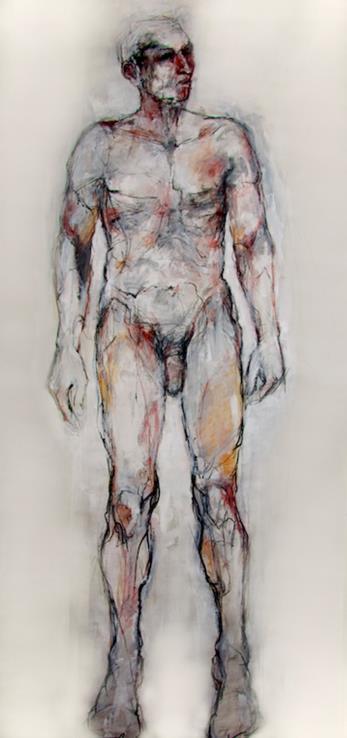

189
Marian Yap. Male Figure. 2006. Monotype on paper. 19 x 16 inches.
Kathleen Yorba. John Doe. 2009. Conte crayon, charcoal, acrylic, ink, pencil on vellum. 72 x 36 inches.
By reversing the gaze and depicting men as vulnerable, as objects to be looked at, I aim to recontextualize masculinity and disempower the image of “mythic” heroic male figures by providing an alternative. Emily Yost
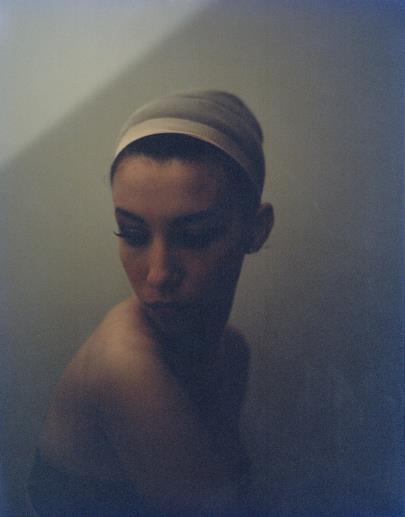


190
Emily Yost. Untitled. 2011. Archival inkjet print. 16 x 20 inches.
Emily Yost. Untitled. 2011. Archival inkjet print. 11 x 14 inches.
Emily Yost. Untitled ('Faux Queen'). 2011. Archival inkjet print. 14 x 11 inches. *
The objectification of women in our society has become a norm. We see the images everywhere, on the TV to magazines, to big street ads. In this project, you will find these same objectifying poses recreated by male models. You might find yourself feeling a little uncomfortable by these men posing in what society categorizes as feminine poses, but please ask yourself, when did the word “feminine” become a code word for sexual objectification? Karen Zack


191
Karen Zack. Icon. 2010. Photography. 16 x 20 inches. *
Karen Zack. Man Kind 2. 2010. Photography. 20 x 40 inches.


192
(left) Lucia Znamirowski. Two Boys Kissing. 2010. Scratch Board. 28 x 22 inches.
(right) Lucia Znamirowski. Timothy. 2010. Graphite on Arches Paper. 24 x 18 inches.





























































 Tracy Brown
Tracy Brown


 Calfee
Calfee







 Janie Cohen
Janie Cohen







































 Govindnathan
Govindnathan





 Karen Gutfreund
Karen Gutfreund

 Tania Hammidi
Tania Hammidi

 Hallier
Hallier
































































 Michelle Lopez
Michelle Lopez
















 Kristina Martino
Kristina Martino







































































 Colette
Colette






















































